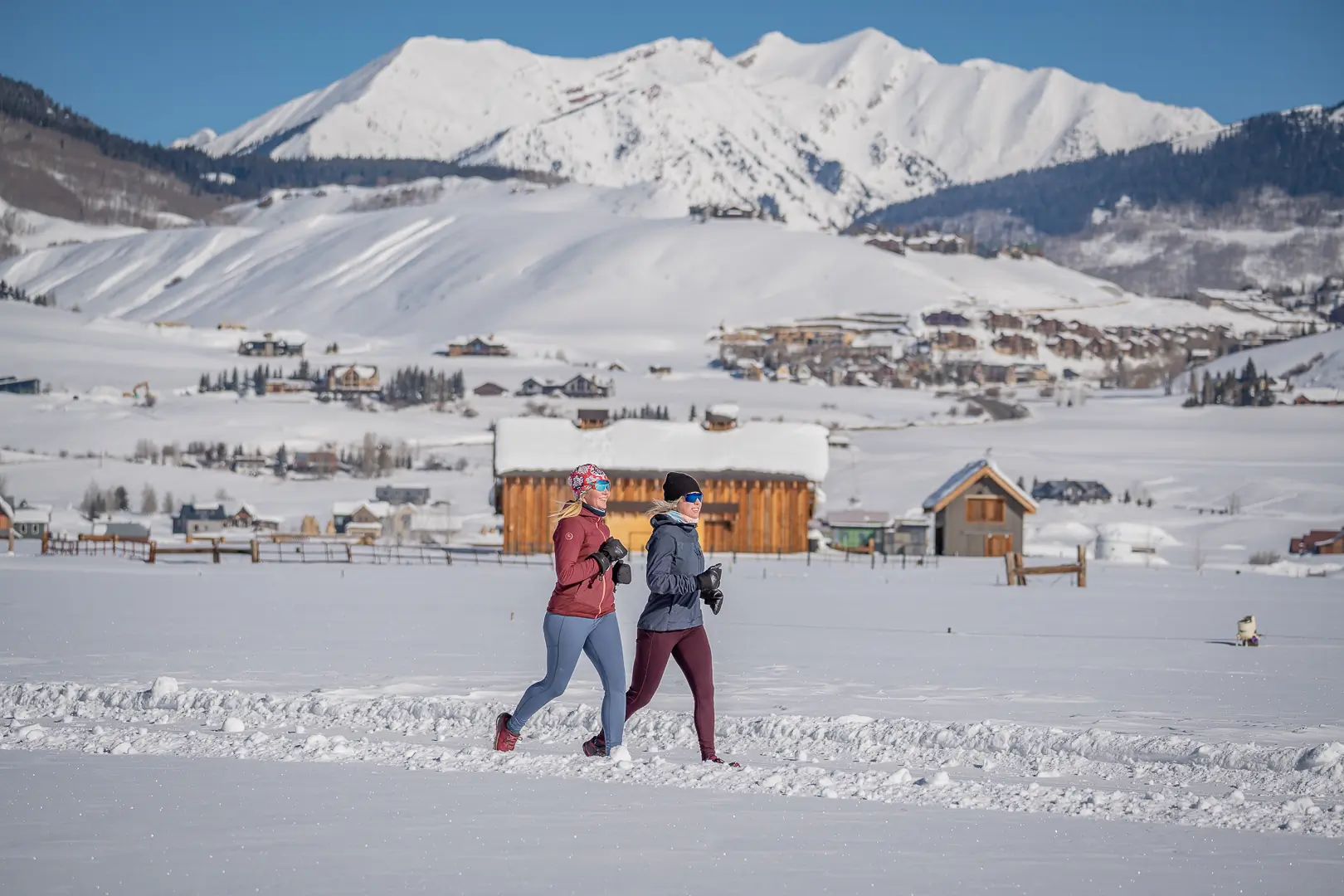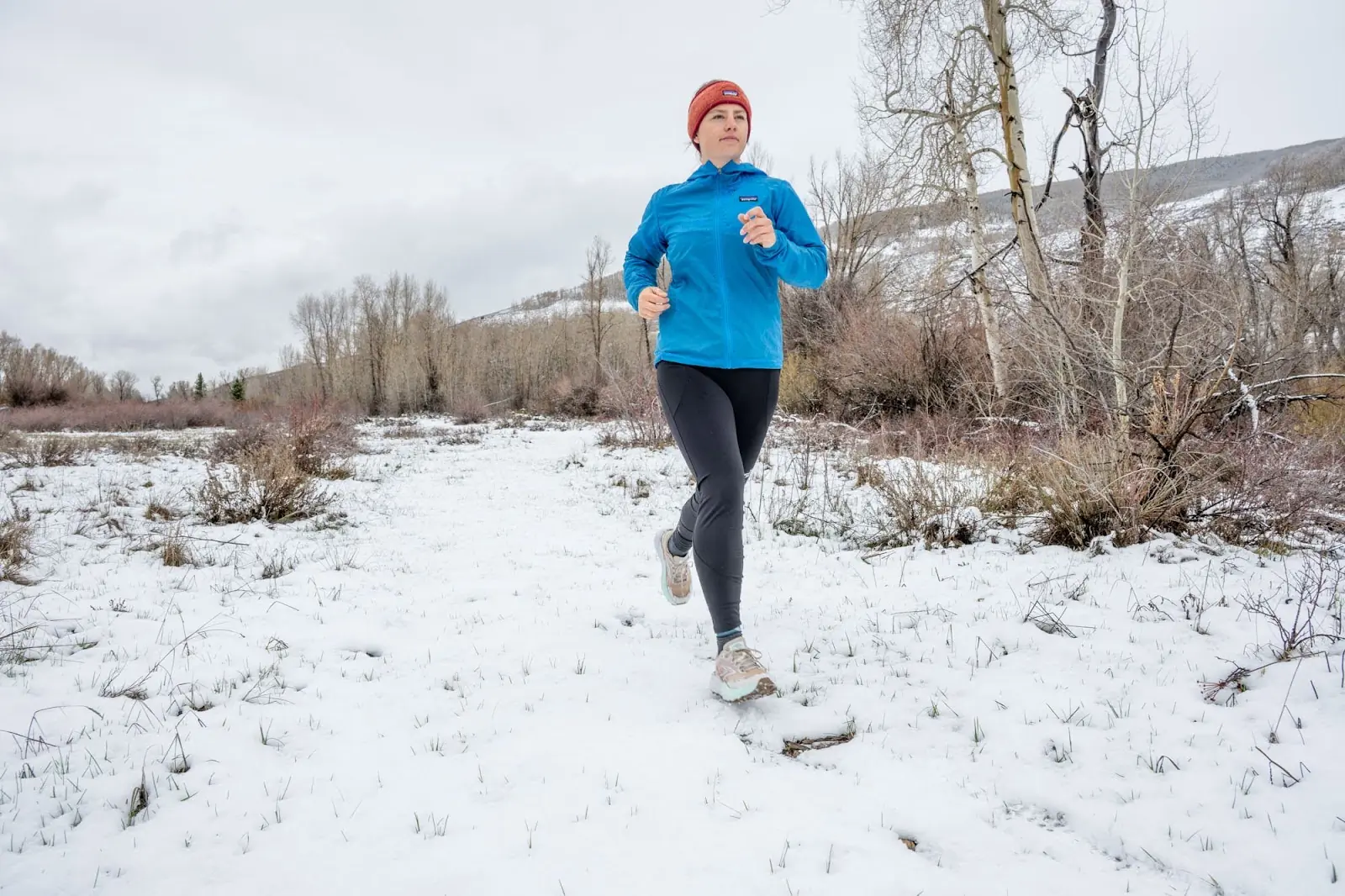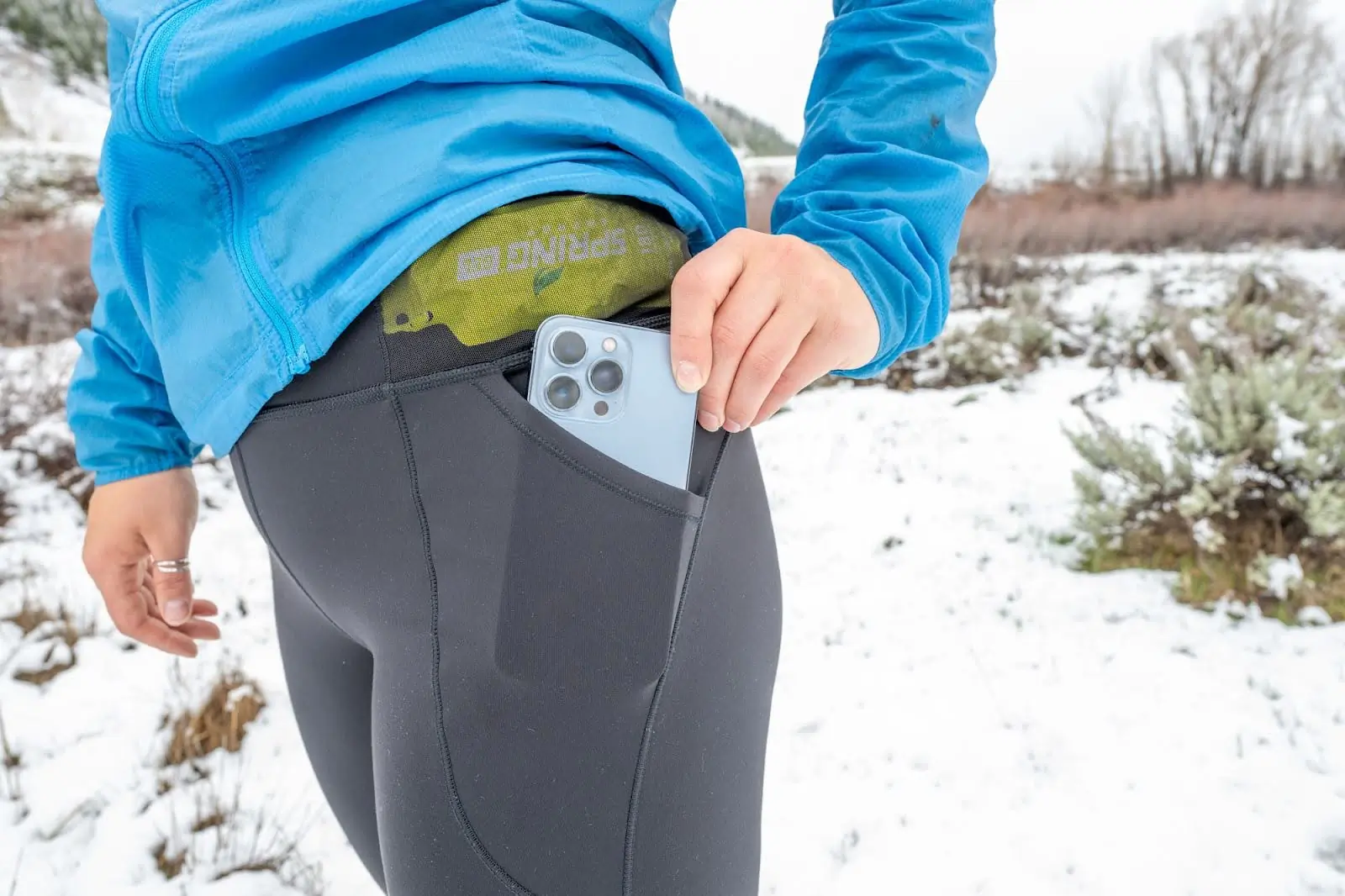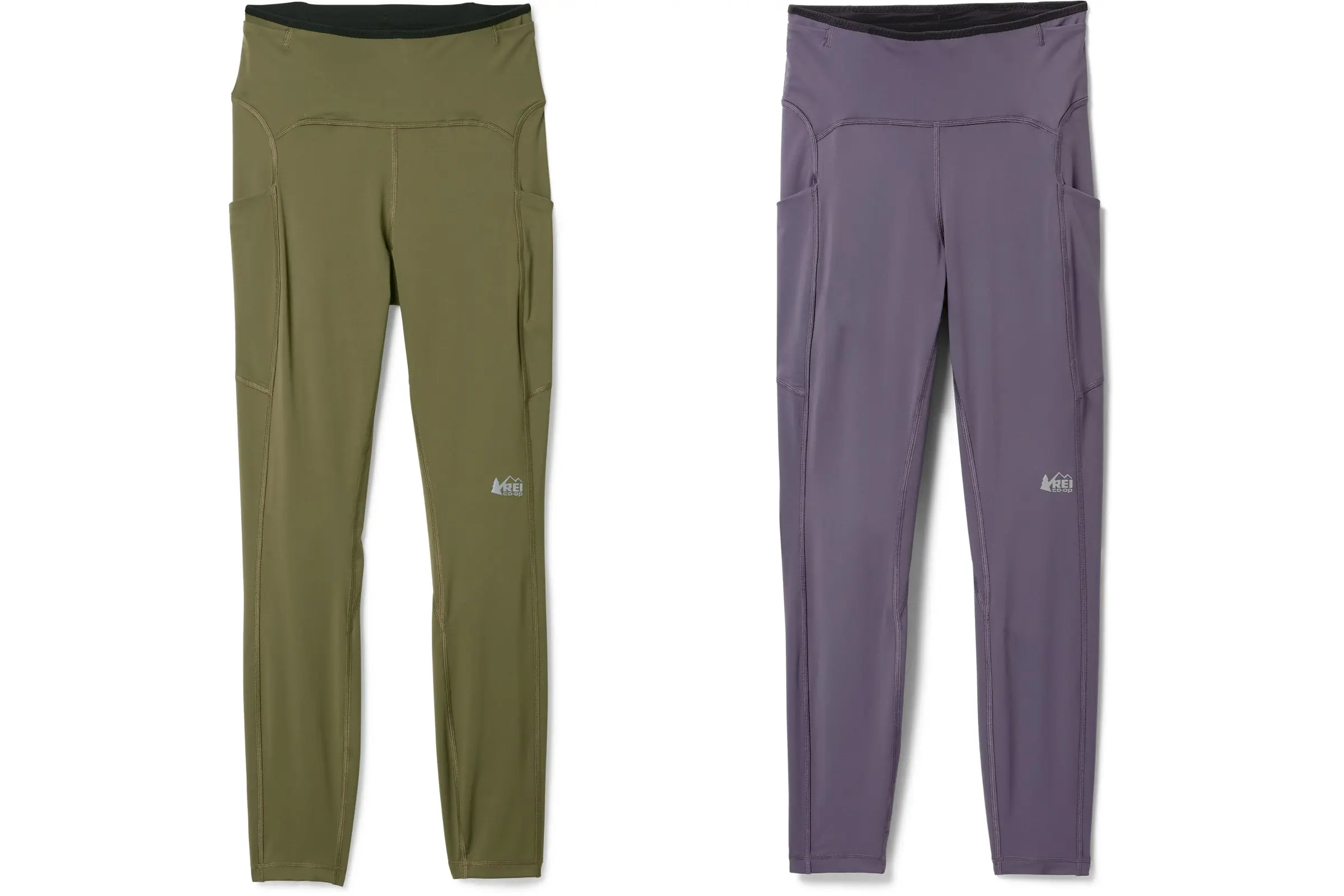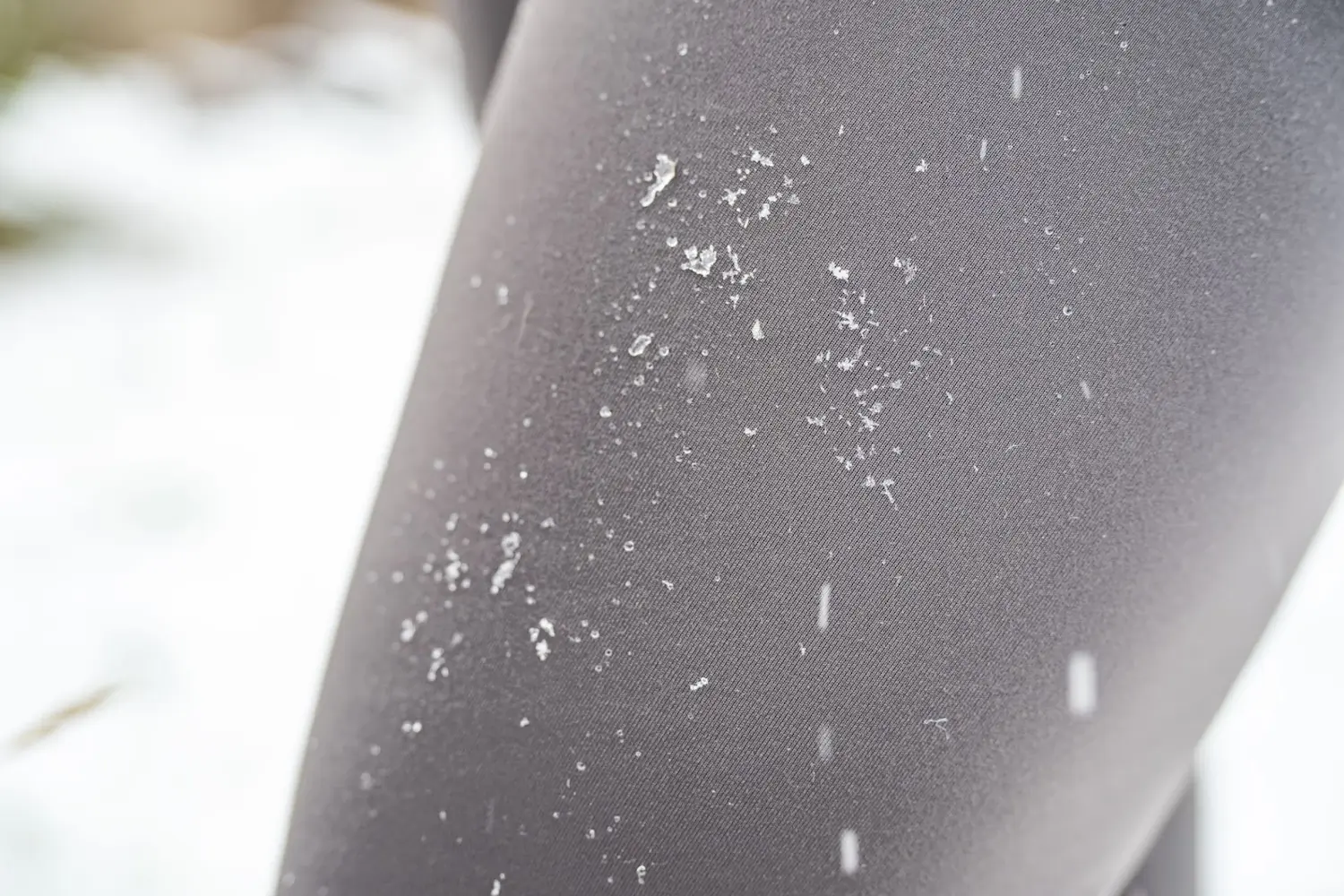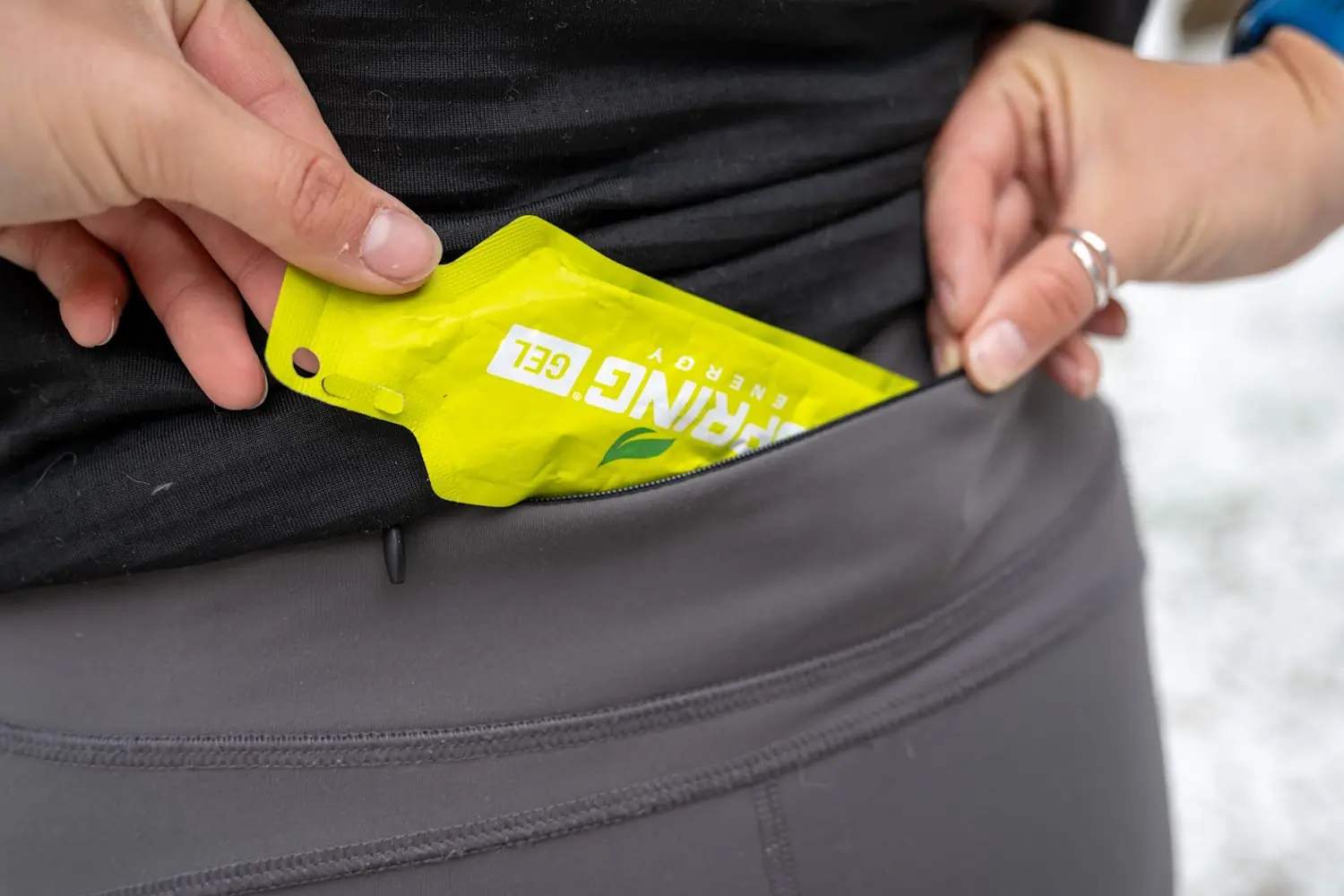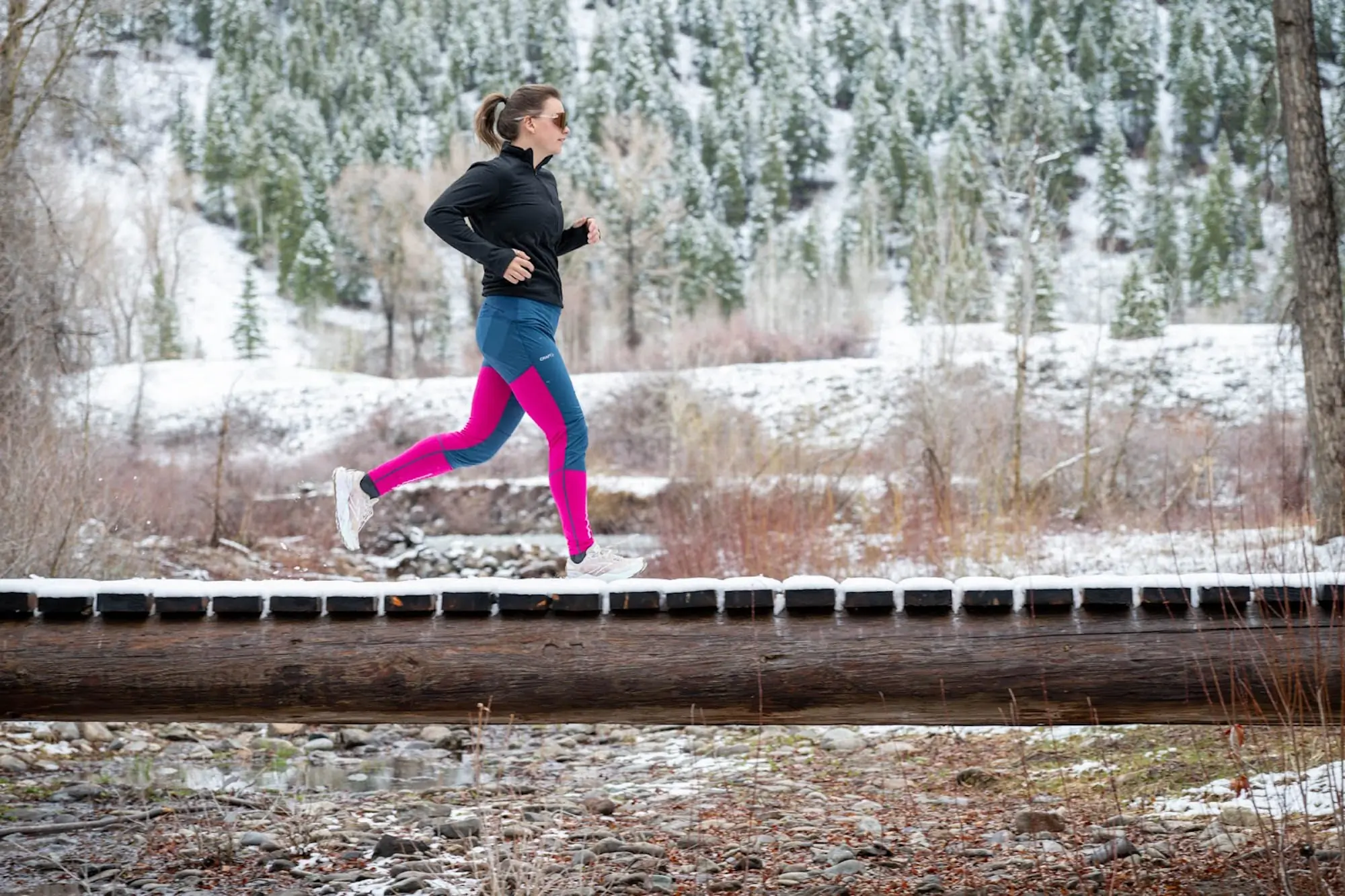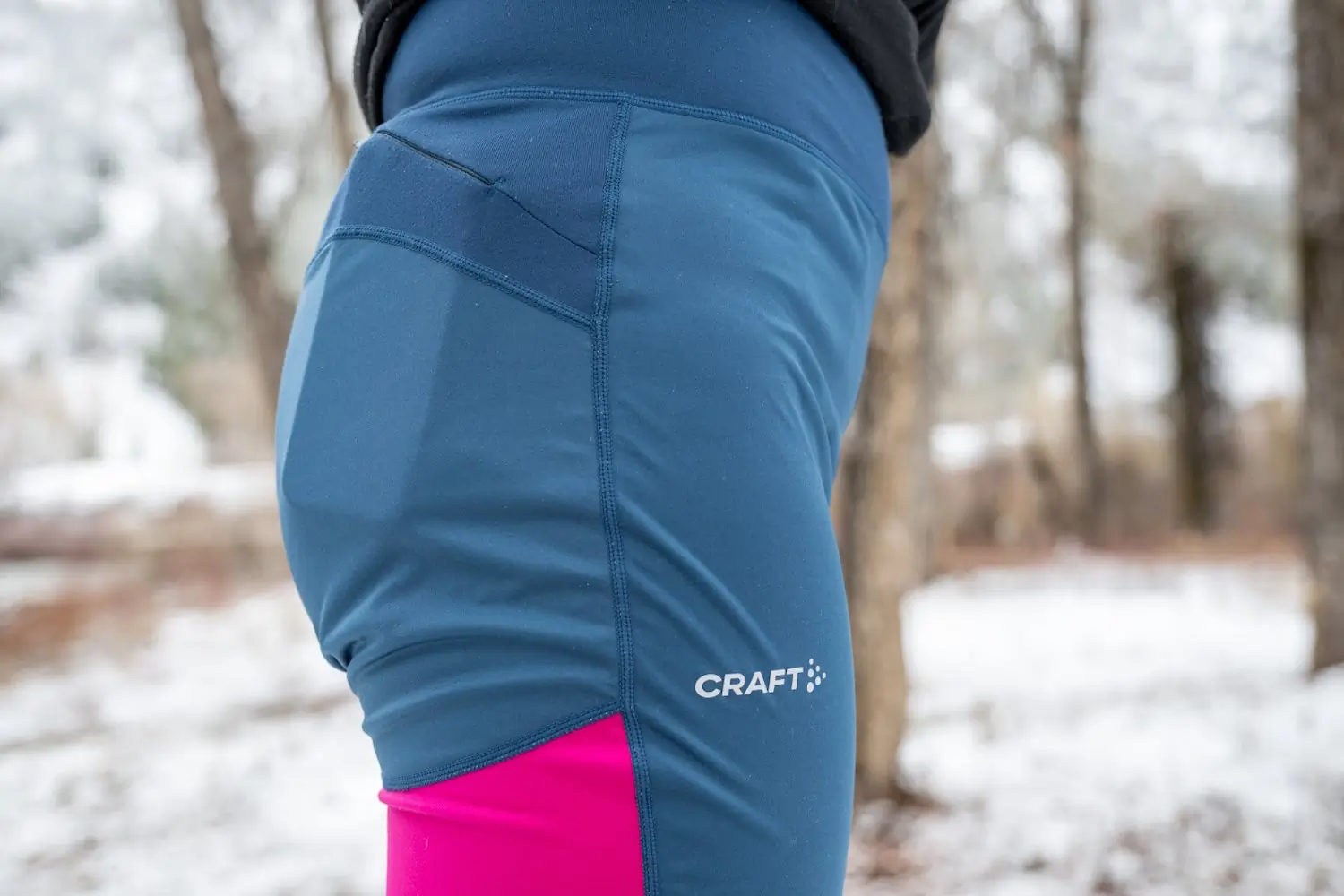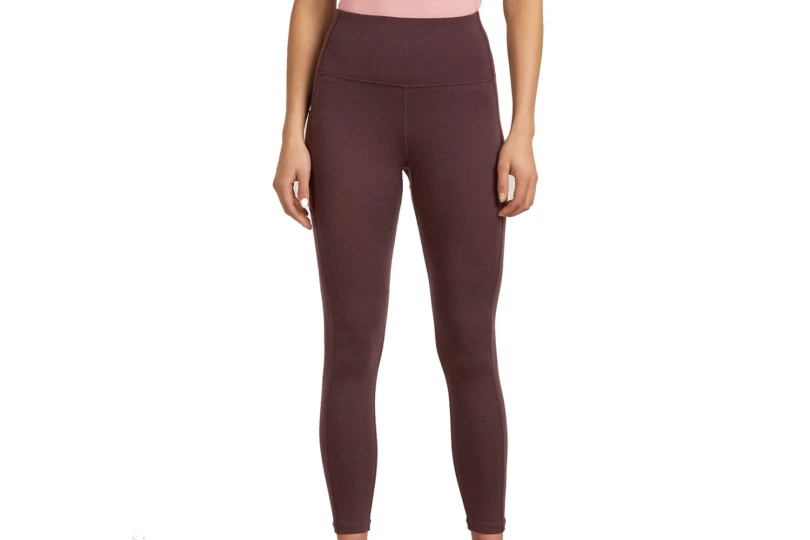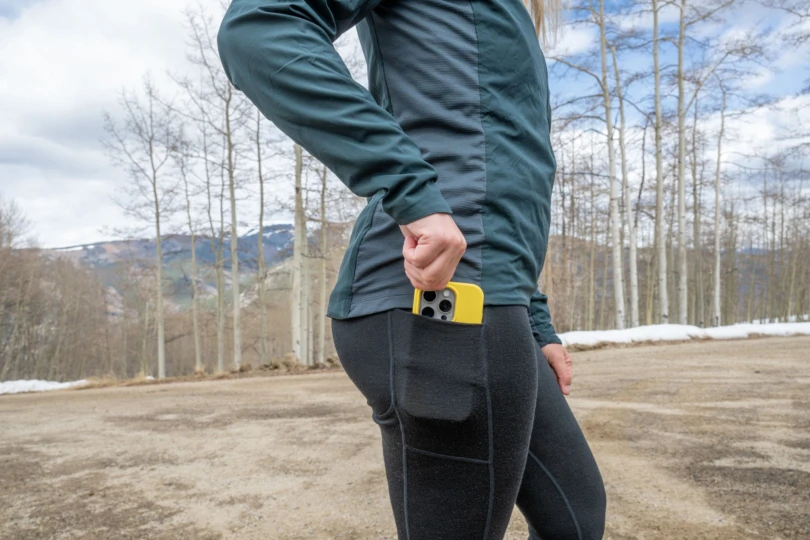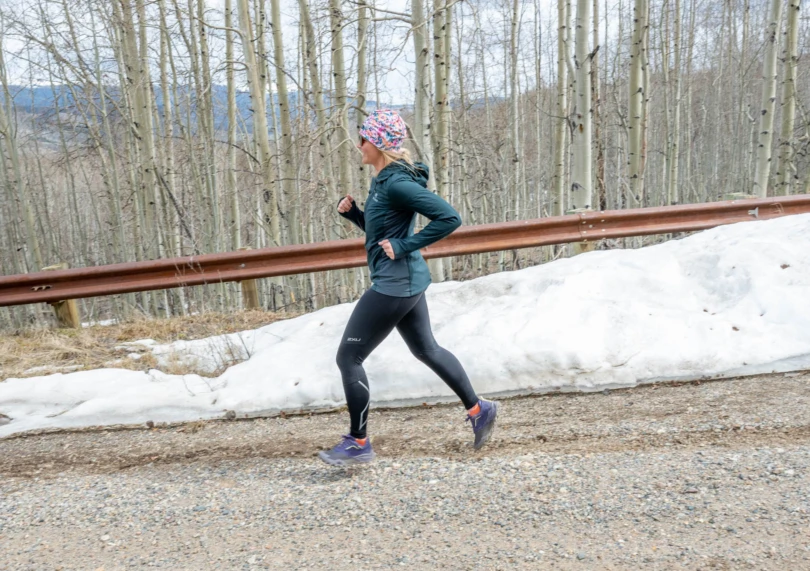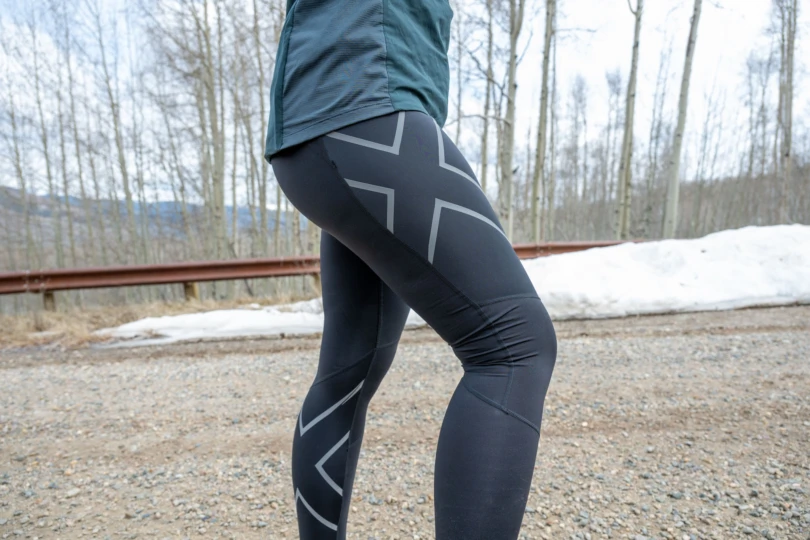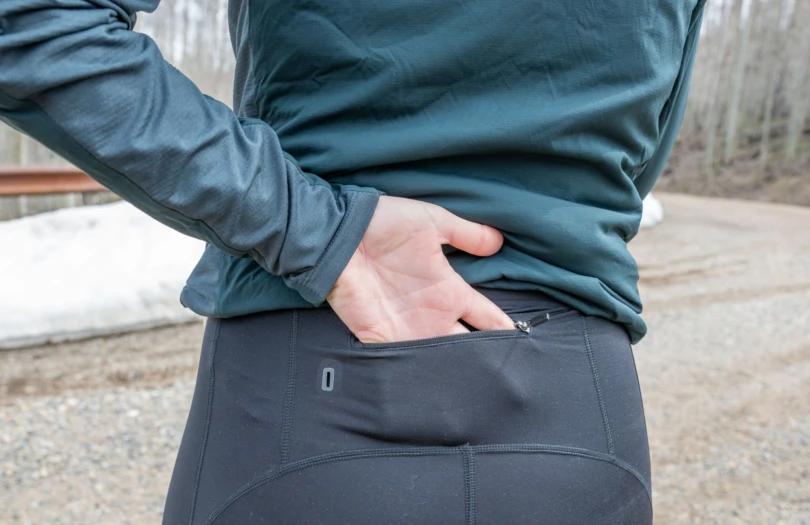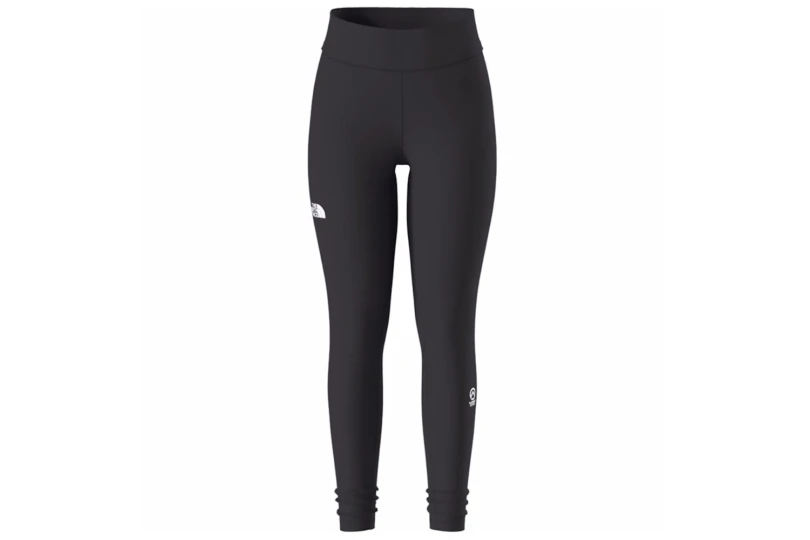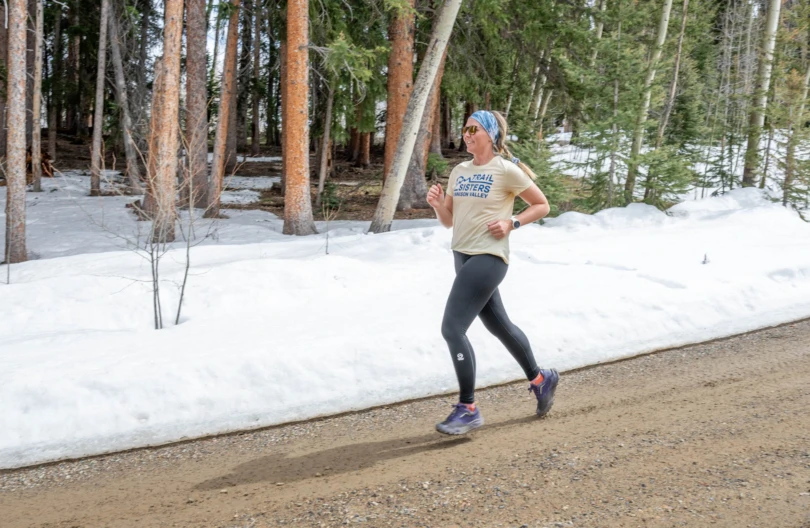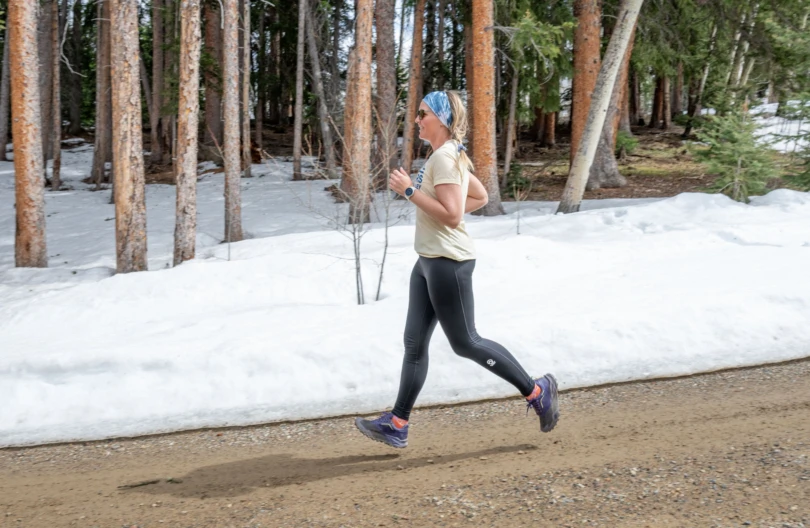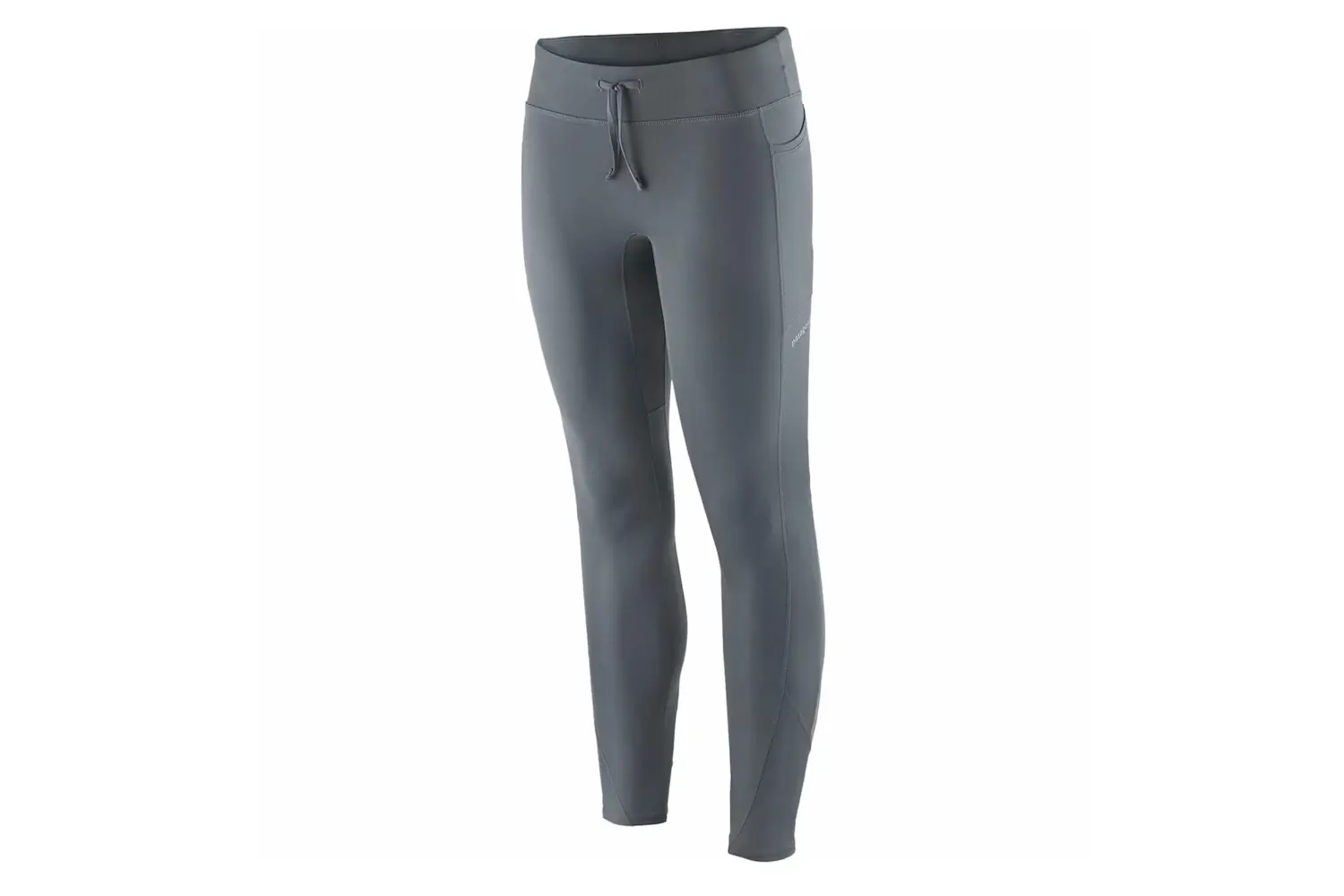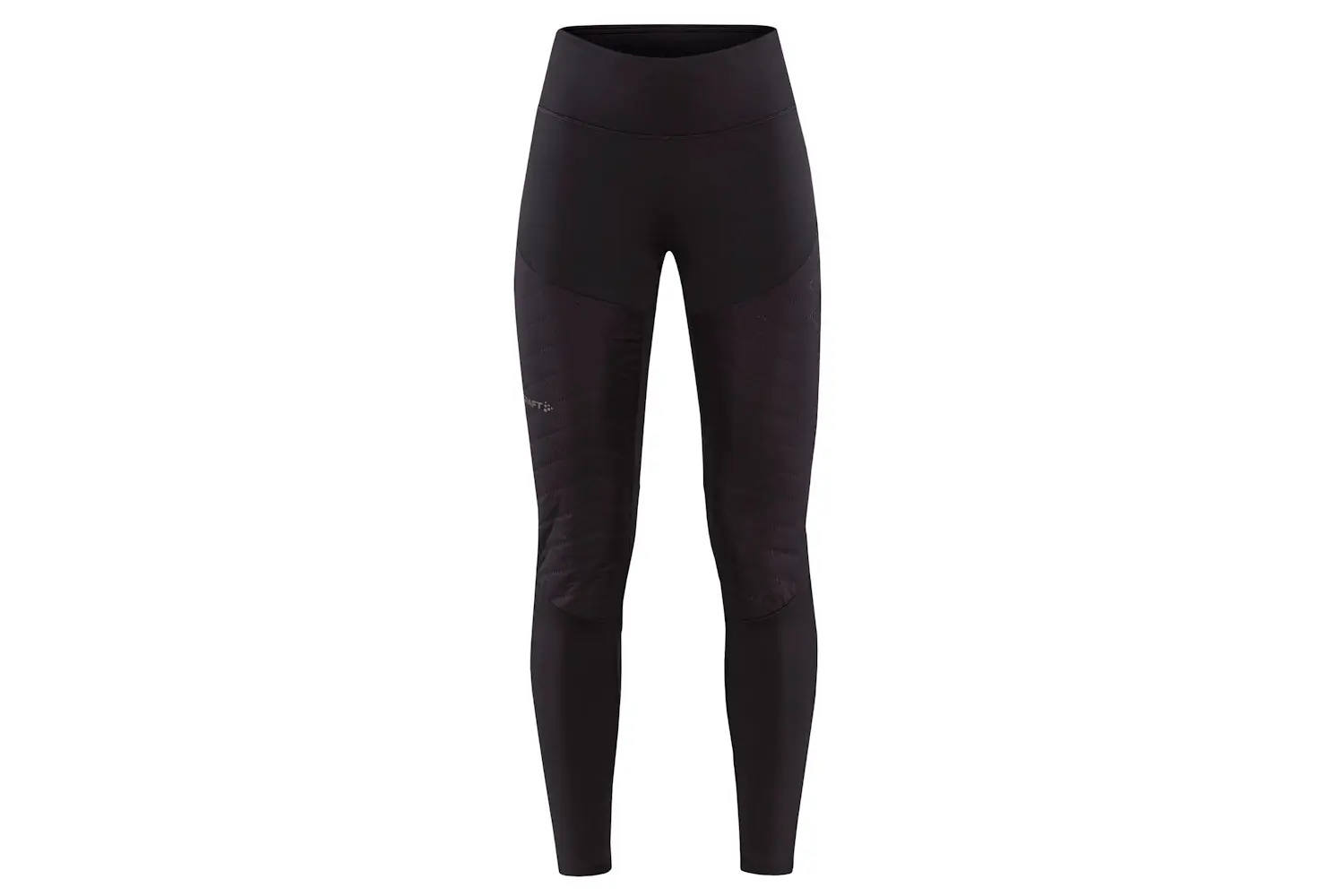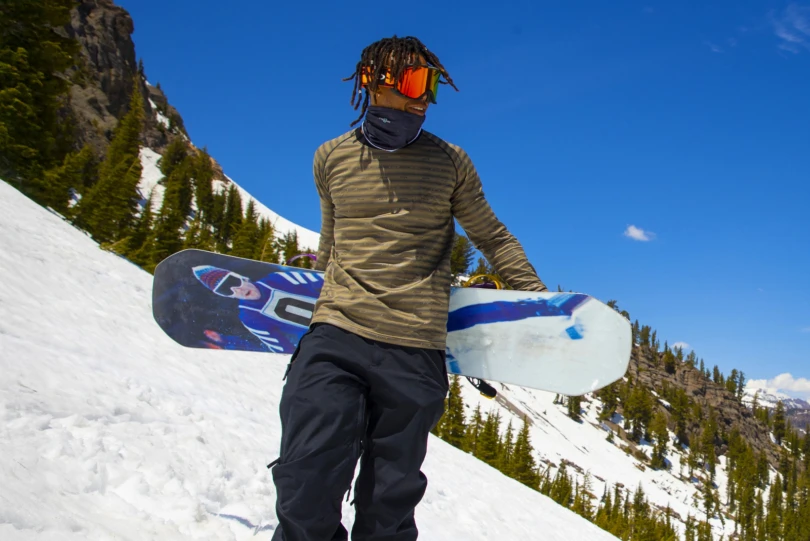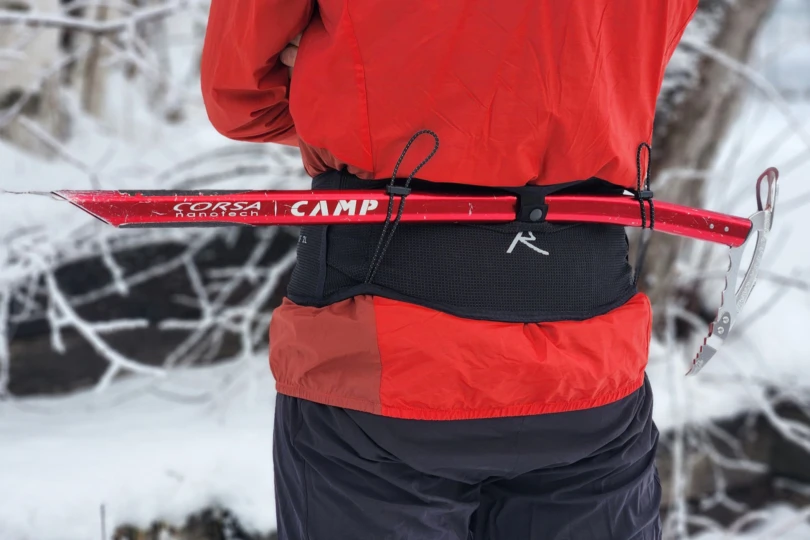From crisp mornings to arctic blasts, winter runs dish out plenty of mood swings. But the right pair of women’s winter running tights can help you power through the miles rather than bailing early.
You might need a pair of women’s winter running tights with wind protection, like the Craft ADV Essence Wind Tights, or a water-resistant design like the The North Face Women’s Winter Warm Pro Tights. Other options have more insulation for the coldest conditions, including the brushed fleece liner in the Rabbit Defroster Speed Tights and the merino wool in the legs of the Smartwool Women’s Active Fleece Wind Tight.
We’ve created this guide to help you stay warm and dry on the worst weather days, the stunning bluebird days, and everything in between. Most of these winter tights are versatile and wearable for winter hikes or Nordic skiing and they work well for the shoulder seasons. All in all, the investment goes a long way.
Editor’s Note: We updated our Women’s Winter Running Tights buyer’s guide on September 22, 2025, with the freshly tested and award-winning Norrona Femund WarmWool1 Flex2 Tights, 2XU Ignition Shield Compression Tights, and Icebreaker Women’s Merino 260 Fastray High Rise Tights, as well as The North Face Women’s Summit Series Pro 120 Tights.
The Best Women’s Winter Running Tights of 2025-2026
Best Overall Women’s Winter Running Tights
The North Face Women’s Winter Warm Pro Tights
9.5/10 RatingBest Budget Women’s Winter Running Tights
REI Co-op Swiftland Thermal Running Tights – Women’s
8.9/10 RatingBest Women's Winter Running Tights for Windy Conditions
Craft Women’s ADV Essence Wind Tight
9.1 /10 RatingBest High Rise Women’s Winter Running Tights
Icebreaker Merino 260 Fastray High Rise Tights
8.4/10 RatingThe North Face Women’s Winter Warm Pro Tights
- Number of pockets: 5
- Pant rise: Mid rise
- Fleece lining: Yes
- Gusset: Yes
- Inseam: 27.625"
Pros
- Ready for an array of weather
- Super comfortable
- Waistband doesn’t slide down
Cons
- Shorter inseam (ends above ankle)
- We’d like to see more reflective material
REI Co-op Swiftland Thermal Running Tights – Women’s
- Number of pockets: 5
- Pant rise: Mid rise
- Fleece lining: No
- Gusset: Yes
- Inseam: 28”
Pros
- Gusset and triangle-shaped interior leg seams prevent chafing
- Contains Bluesign-approved materials
- Flat seam construction helps prevent friction
Cons
- Waistband pockets have no closure
Rabbit Defroster Women’s Speed Tights
- Number of pockets: 5
- Pant rise: Mid rise
- Fleece lining: Yes
- Gusset: Yes
- Inseam: 25.5”
Pros
- Grippy drawstring that stays tied
- Eco-friendly PFC-free water-resistant finish on face fabric
- Reflective seams
- Very soft
Cons
- Shorter inseam
- Fabric does lightly pill
- Comes only in one gray color
Norrøna Femund Warmwool1 Flex2 Tights
- Number of pockets: 4
- Pant rise: High rise
- Fleece lining: Yes
- Gusset: Yes
- Inseam: 30”
Pros
- Luxurious-feeling wool
- Multiple pockets
- Comfortable waistband
Cons
- Expensive
- Ankle zippers do not have a gusset
Craft Women’s ADV Essence Wind Tight
- Number of pockets: 1
- Pant rise: Mid rise
- Fleece lining: Yes
- Gusset: Yes
- Inseam: 29.5″
Pros
- Windproof
- Comfortable waist
- Reflective details
Cons
- Run small
- Weird pocket placement
Icebreaker Merino 260 Fastray High Rise Tights
- Number of pockets: 1
- Pant rise: High rise
- Fleece lining: No
- Gusset: Yes
- Inseam: 25
Pros
- Excellent moisture management
- Comfortable, mobile fit
- Practical design details
Cons
- Short inseam
- Limited weather protection
- Slightly higher price point
2XU Ignition Shield Compression Tights
- Number of pockets: 1
- Pant rise: High rise
- Fleece lining: Yes
- Gusset: Yes
- Inseam: 28”
Pros
- Tall sizes
- Oversized reflective logos
- Waterproof thigh panels
Cons
- Runs slightly small
- Snug waistband
Other Women’s Winter Running Tights for Turbulent Weather
- Number of pockets: None
- Pant rise: Mid rise
- Fleece lining: No
- Gusset: No
- Inseam: 29”
Pros
- Lightweight
- Breathable
- Excellent moisture wicking
Cons
- Tight around calves
- Runs small
- Minimal stretch
- Number of pockets: 2 zippered hand pockets (9” x 6.5”)
- Pant rise: Mid rise
- Fleece lining: Yes
- Gusset: No
- Inseam: 28”
Pros
- Super soft and comfortable
- Can be used as a layering system over other tights
- Long-lasting fabric sans signs of pilling
Cons
- No reflective seams or logos
- Lacks tall sizing option
- Only comes in one color
- Number of pockets: 3
- Pant rise: Mid rise
- Fleece lining: Yes
- Gusset: No
- Inseam: 30”
Pros
- Longer inseam
- Durable fabric, no pilling
- Bluesign-certified fabrics
- Flatlock seam technology
Cons
- Uncomfortable waistband
- Number of pockets: 3
- Pant rise: Mid rise
- Fleece lining: Yes
- Gusset: Yes
- Inseam: 27"
Pros
- Soft interior microterry liner
- Reflective details
- Comfortable gusset
- Sustainable with Bluesign-approved 68% recycled nylon
Cons
- No zipper on any pocket
- Number of pockets: 2
- Pant rise: Mid rise
- Fleece lining: Yes
- Gusset: Yes
- Inseam: 29.25”
Pros
- Water- and wind-resistant front panels
- Sustainably sourced merino wool
- Flatlock seam construction helps prevent chafing
- Exterior ankle zippers for ease of pulling tapered, fitted tights on and off
Cons
- Pocket is not big enough for a large phone
- Had to retie drawstring mid-activities to keep the tights from sliding down
- Textile on the backside is thin if stretched, like when bending over to tie a shoe
- Number of pockets: 1
- Pant rise: High rise
- Fleece lining: Yes
- Gusset: Yes
- Inseam: 30"
Pros
- Windproof
- Zippered ankle
- Warm
Cons
- Uncomfortable waist
- No zipper underlay
- Number of pockets: 3
- Pant rise: High rise
- Fleece lining: No
- Gusset: Yes
- Inseam: 28”
Pros
- Durable, premium material
- Fun color-blocking and aesthetic
- Comfortable waistband
- Ankle zippers for smoother process pulling on and off
Cons
- Legs tend to slip down
- Short internal drawstring
- Small envelope flap leaves pockets unsecure
- Number of pockets: 4
- Pant rise: High rise
- Fleece lining: Yes
- Gusset: Yes
- Inseam: 28”
Pros
- Under $100
- Fabric is composed of 88% recycled polyester
- Long internal drawstring
- Slide-through pocket at lower back to thread your shirt on hot days
Cons
- Not ideal for high moisture
- Unflattering front seam construction
- Number of pockets: 2
- Pant rise: High rise
- Fleece lining: Yes
- Gusset: Yes
- Inseam: 28”
Pros
- Comfy and snug
- Broad size run goes from XS to 2XL
- Recycled polyester (74%)
- Low-profile internal drawstring
Cons
- Not windproof
- Seams started popping right away
- Tight waistband
Women’s Winter Running Tights Comparison Chart
| Women’s Winter Running Tights | Price | Pockets | Fleece Lining | Windproof Fabric | Water Resistance |
|---|---|---|---|---|---|
| The North Face Women’s Winter Warm Pro Tights | $100 | 5 | Yes | No | No |
| REI Co-op Swiftland Thermal Running Tights – Women’s | $85 | 5 | Yes | No | No |
| Rabbit Defroster Women’s Speed Tights | $135 | 5 | Yes | No | Yes |
| Norrøna Femund Warmwool1 Flex2 Tights | $199 | 4 | Yes | No | Yes |
| Craft Women’s ADV Essence Wind Tight | $95 | 1 | Yes | Yes | No |
| Icebreaker Women’s Merino 260 Fastray High Rise Tights | $120 | 1 | No | No | No |
| The North Face Women’s Summit Series Pro 120 Tights | $100 | 0 | No | No | No |
| 2XU Ignition Shield Compression Tights | $110 | 1 | Yes | No | Yes |
| La Sportiva Primal Pant | $119 | 3 | Yes | No | No |
| Patagonia Women’s Peak Mission Tights 27″ | $129 | 3 | Yes | No | No |
| Brooks Momentum Thermal Pant | $95 | 2 | Yes | No | No |
| Rabbit Defroster Speed Tights | $135 | 5 | Yes | No | Yes |
| Smartwool Women’s Active Fleece Wind Tight | $150 | 2 | Yes | Yes | Yes |
| Craft ADV Subz Warm Running Tights 3 | $120 | 1 | Yes | Yes | No |
| On Running Performance Tights | $120 | 3 | No | No | No |
| New Balance Impact Run Heat Tight | $90 | 4 | Yes | No | No |
| Salomon Cross Warm 28” | $90 | 2 | Yes | No | No |

How We Tested Women’s Winter Running Tights
Known as one of the coldest places in the lower 48, Colorado’s Gunnison Valley is an ideal testing location for winter apparel. Harsh storms coupled with below-freezing temps provide our testers with extreme elements. Situated in high-altitude peaks between 9,000 and 11,000 feet, there’s ample precipitation: Snow with high water content has been prevalent, as well as dry snow. In an arid climate, humidity is one factor that’s left out.
Our Expert Testers & Testing Grounds
At the helm of the snowsports buyer’s guides, GearJunkie Senior Editor Morgan Tilton has more than 3 decades of experience wearing down snow apparel in mountainous winter climates and more than a decade of outdoor industry and product reporting under her belt.
Leading our women’s winter running tights test, Constance Mahoney is an experienced runner competing in a range of distances from local 5Ks to trail ultramarathons with a preference for vertical. She founded the Trail Sisters Crested Butte, Colo., chapter in 2021, which she still organizes.
Constance has been a GearJunkie contributor since 2019, after she reviewed outdoor gear for FitnessTravelGear.com for 2 years. Her specialties range from running and camping to hiking, angling, hunting, and photography — her landscape and wildlife images are viewable in RedLine Gallery in Crested Butte.
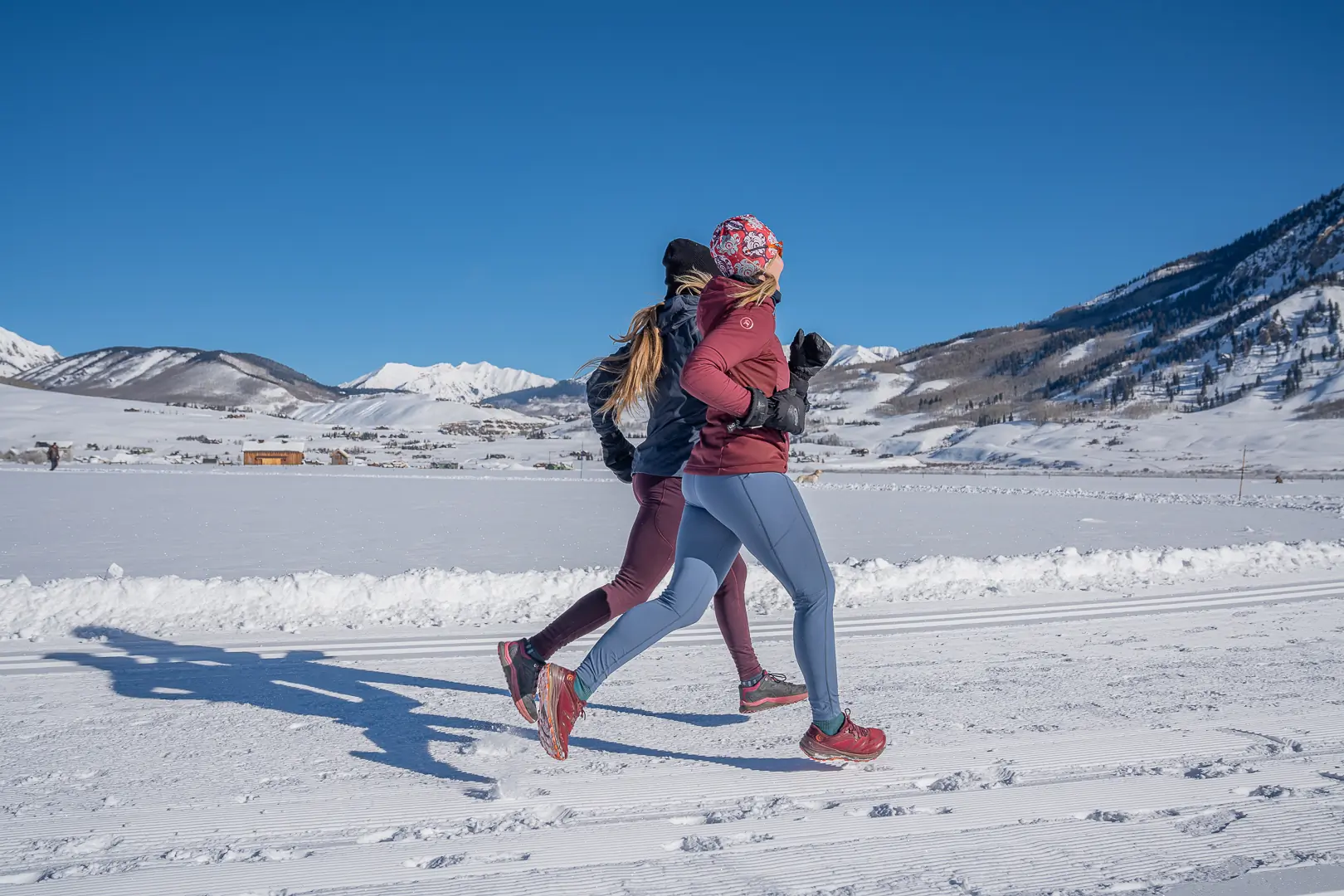



Our Testing Process
To put these women’s winter tights to the test, we ran in a range of conditions from absolutely freezing (-10 below) to cold (5 to 30 degrees) and mild temperatures (30 to 40 degrees). We ran for short and long distances while the snow was lightly or fiercely falling, under sunshine, and while being blasted by wind.
Miles included uphill sprints, workouts, and slow slogs. We jaunted with a variety of supplies in the pockets including fuel, gloves, key, IDs and credit cards, and large devices. We washed, dried, and put each pair through the rounds including a deep inspection about how and why each pair was made.
Over the last two winters of testing, Mahoney has paced, crewed, and coached her husband as he prepares for his annual 100-mile race. This means putting in the outdoor miles no matter the conditions. She has postholed her way to the main roads before the plows reached her area, ran during complete whiteouts, and endured below-zero temps, all in the name of being a “training partner.”
To help narrow down the best choices for testing, we also researched the most acclaimed, award-winning, popular, innovative, legacy, and new offerings out there today in addition to our team’s insight as runners.
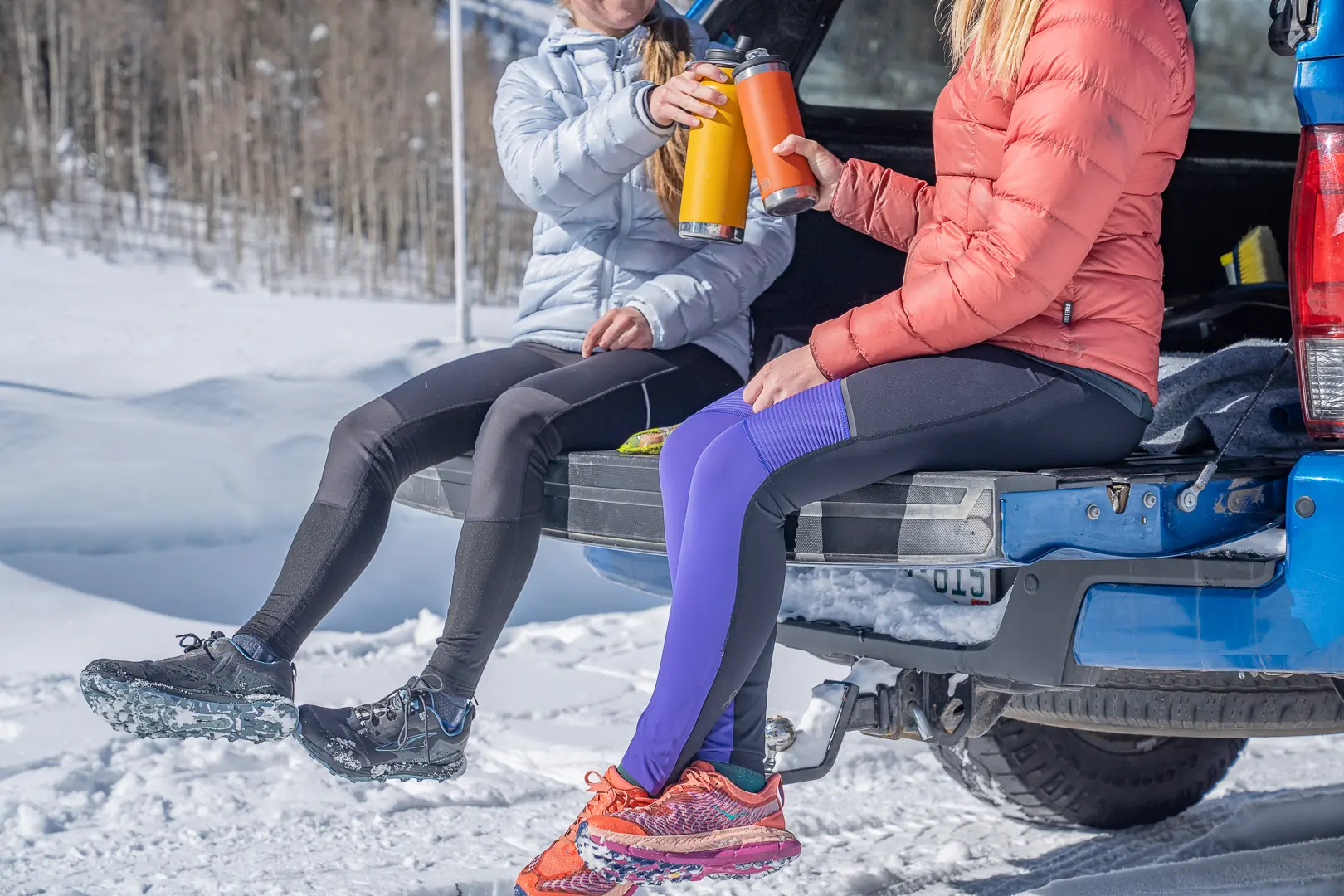



Buyers Guide: How to Choose Women’s Winter Running Tights
In our perspective, the best women’s winter running tights can be used for a variety of activities — not just running. When looking at what to purchase, keep that in mind: For what other activities might you want to use this cold-weather pant?
Alternatively, the tights can be solely dedicated to runs. If you spend the majority of your time shuffling your feet mile over mile, you might be excited to treat yourself to a pair of cold-season leggings for the sport.
Most importantly, you’ll need to consider what kind of winter weather you will be running in. From there, you’ll be able to determine what design elements are key to help you stay warm, dry, and happy.
The biggest differentiators of women’s winter tights include how much insulation, water resistance, and windproofness you need in addition to overall fit, pocket design, and price.
Our crowned choice, The North Face Women’s Winter Warm Pro Tights has major reinforcements to help keep you warm and dry on your winter adventures: a quick-wicking fabric, called FlashDry, plus two lined hand warmer pockets.




Fabric: Women’s Winter Running Tights
Many different types of textiles and fabric blends are used to make the best women’s winter running tights.
The most popular mixes are polyester or nylon paired with a synthetic elastic fiber — like elastane, Lycra, or spandex — to hold the cloth together and help maintain tightness, rebound, and shape.
Some tights incorporate natural wool, which is typically combined with human-made fibers for performance-oriented apparel, and merino wool is the most popular variety.
One major consideration when examining fabric is the environmental footprint: Are there any recycled or renewable materials in the design? We are starting to see more brands offer earth-friendlier fabrics and manufacturing practices, though we would like to see more. Consumers can be involved with that trend through what they buy and the direct feedback that they provide brands.
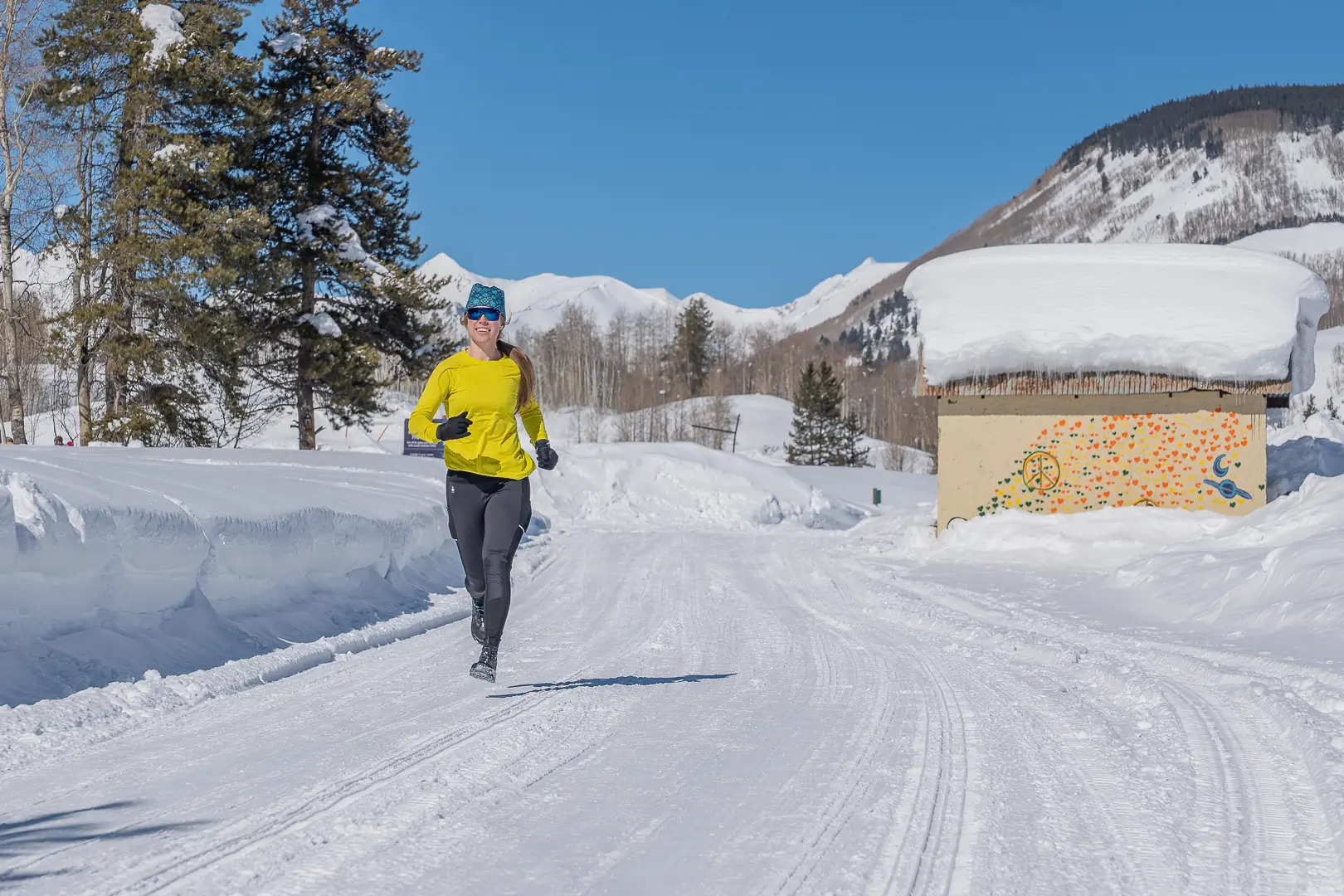



Recycled Synthetic Materials
Polyester and nylon (a type of artificial polyamide) are popular synthetic fabrics for activewear but shed microfibers: very small pieces of petroleum-based plastic, less than 100 mm in length, that take decades to decompose. Both materials feel silky, almost slippery. They are very elastic, strong enough to retain their shape after multiple uses, wrinkle resistant, and quickly dry.
These days, polyester, nylon, and other polyamide fabrics are available in a recycled form, and many brands are shifting to that route to alleviate their carbon footprint.
Among our buyer’s guide picks, these products feature recycled polyester:
- New Balance Impact Run Heat Tight
- La Sportiva Primal Pant
- The North Face Women’s Winter Warm Pro Tights
- Salomon Cross Warm 28
These tights use recycled polyamide:
Patagonia leads the charge with recycled nylon while it aims to transition completely away from virgin material: 89% of the nylon used in the company’s apparel is recycled, as of spring 2023. To achieve that goal, the brand uses ECONYL fiber, which is a nylon yarn that combines 50% postconsumer nylon — like thoroughly cleaned then melted fishing nets and discarded carpet — with 50% pre-consumer nylon waste, i.e., industrial plastic that would’ve otherwise been downcycled or thrown out. The Patagonia Peak Mission Tights 27” ($129) are 68% recycled nylon, 15% polyester, and 17% spandex jersey.
With the inclusion and increase of recycled materials, we have not noticed a drop in quality or performance in the products we’ve tested and will note if we do.
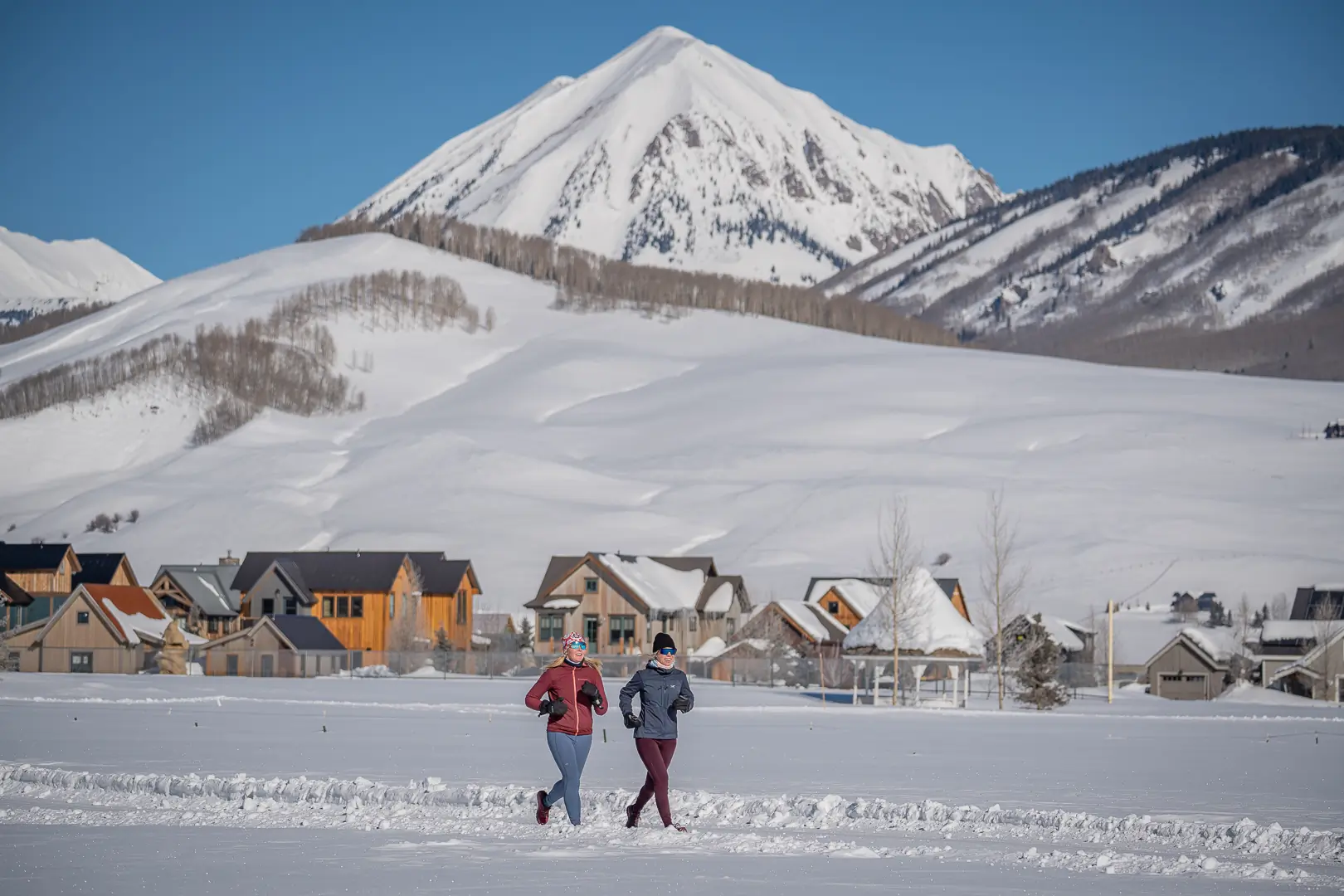



Synthetics vs. Wool
Wool is a natural, renewable fiber grown from sheep that’s known for providing excellent warmth, thanks to the crimpy fibers that trap air, insulating the skin, yet the fibers are breathable.
Wool has a protein structure that allows the fiber to absorb moisture, holding up to 30% of its weight before feeling damp, according to the University of Waikato and CSIRO, an Australian Government science organization.
Additionally, the sebaceous glands of sheepskin secrete a grease, aka wax, which can be refined into lanolin, that protects the raw fibers and makes them water repellent. Though the wax coating is removed in the manufacturing process, the wool fibers remain stubbornly resistant to water.
The natural material is also antimicrobial with an ability to absorb excessive odor-causing bacteria, thus preventing smelly apparel, according to a 2022 study published in the peer-reviewed Molecules Journal of Chemistry.
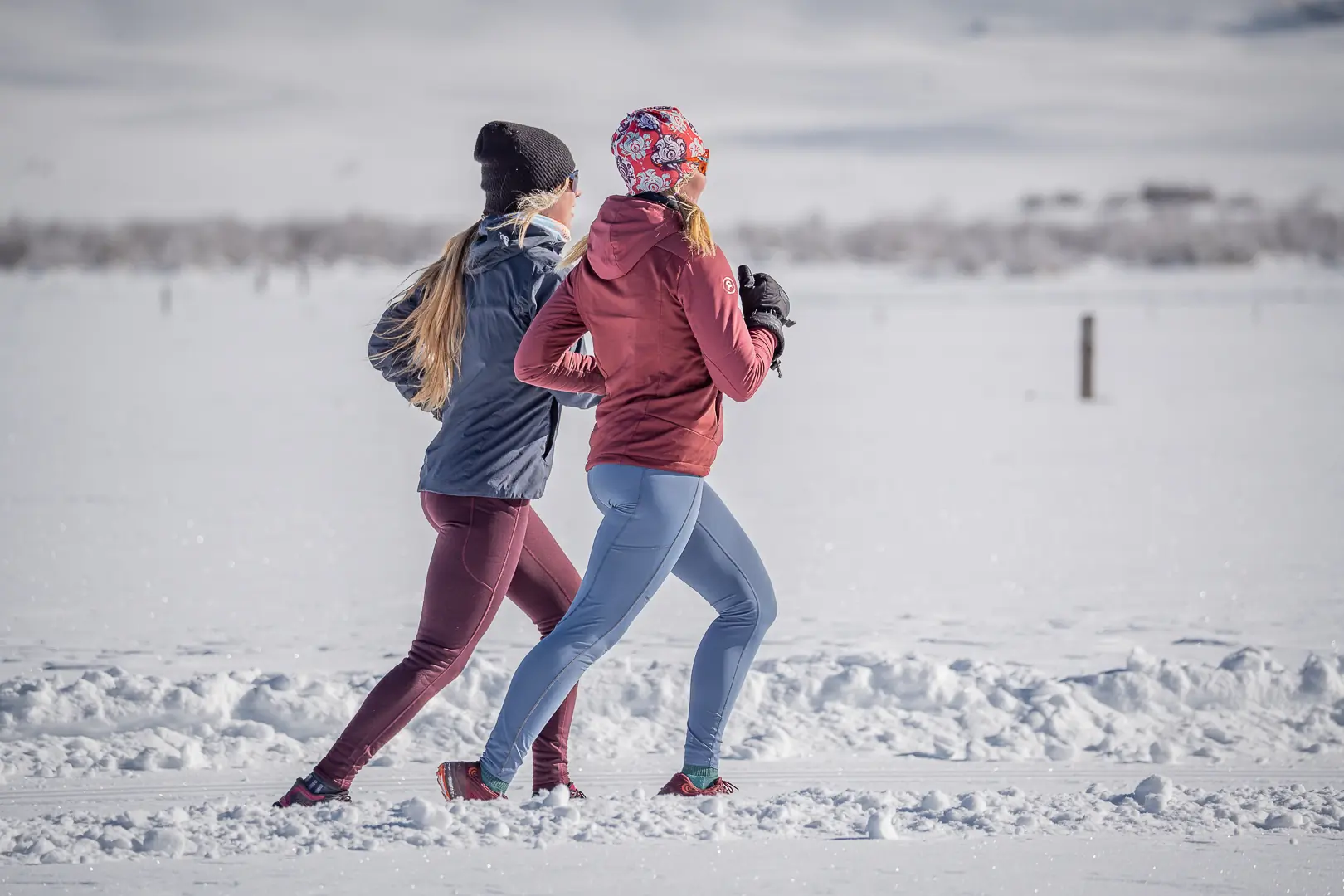



With so many great qualities, typically wool has a higher price tag. The Smartwool Active Fleece Wind Tight is one option that utilizes merino wool, and the cost for quality is premium at $150.
Drawbacks? While wool does retain warmth, it doesn’t dry as fast as synthetic materials. Without special reinforcement, wool blends are not much of a wind-blocker. Compared to synthetics, wool tends to be less durable and get saggy throughout use, which is why wool is often woven with other human-made threads, especially for high-cardio activity like running.
Synthetic materials are an excellent tool for elasticity, form-fitting structure, long-term durability, wicking moisture, and drying fast. For warmth, these factory-made materials are often lined with fleece or wool. Overall, synthetics aren’t necessarily soft, they tend to retain B.O., and not all are very breathable — it depends on how tight the weave is and the yarn circumference.
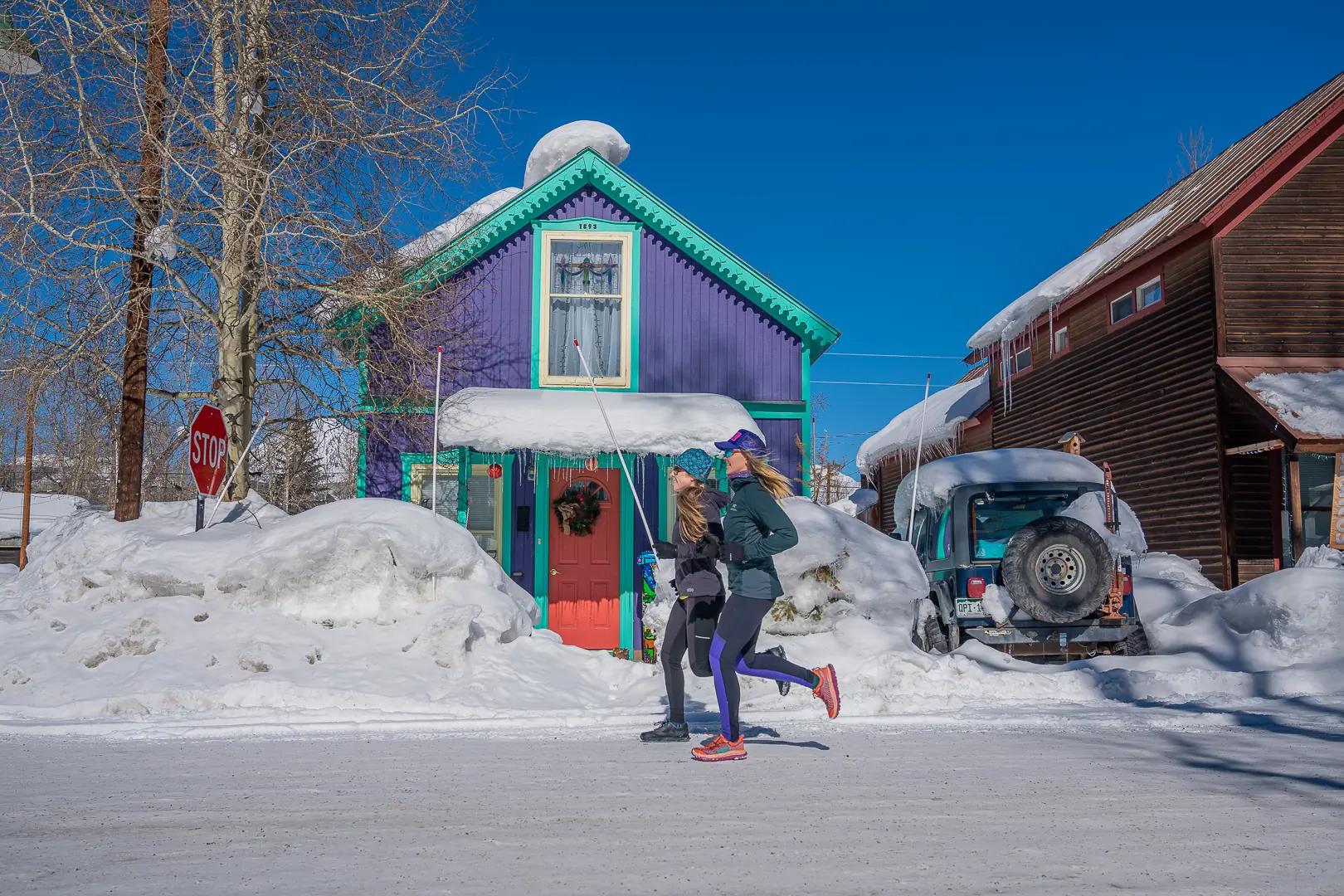



Sustainability: Women’s Winter Running Tights
You can’t see the bits of waste flying off your running tights, but microplastics and microfibers shed from synthetic fabrics — which are woven into all of the winter tights on our list — and contaminate waterways and oceans, according to a study published in the Environmental Science and Pollution Research.
Researchers found that polyester fleece sheds the most, exceeding polyester, as do loose constructions, so high-twist yarn can help reduce fabric shed.
Some brands also work with Bluesign Technologies, based in Switzerland, for third-party verification regarding the sustainability of their manufacturing process. The criteria examine chemical use, water and energy consumption, carbon emissions, and worker health and safety.
If a product carries a Bluesign label, that means the sourced materials or overall product meet the outdoor industry’s global benchmark of environmental standards. In this guide, Bluesign-certified products include the following winter running tights:
- REI Co-op Swiftland Thermal Running Tights – Women’s
- La Sportiva Primal Pant
- Brooks Momentum Thermal Pant
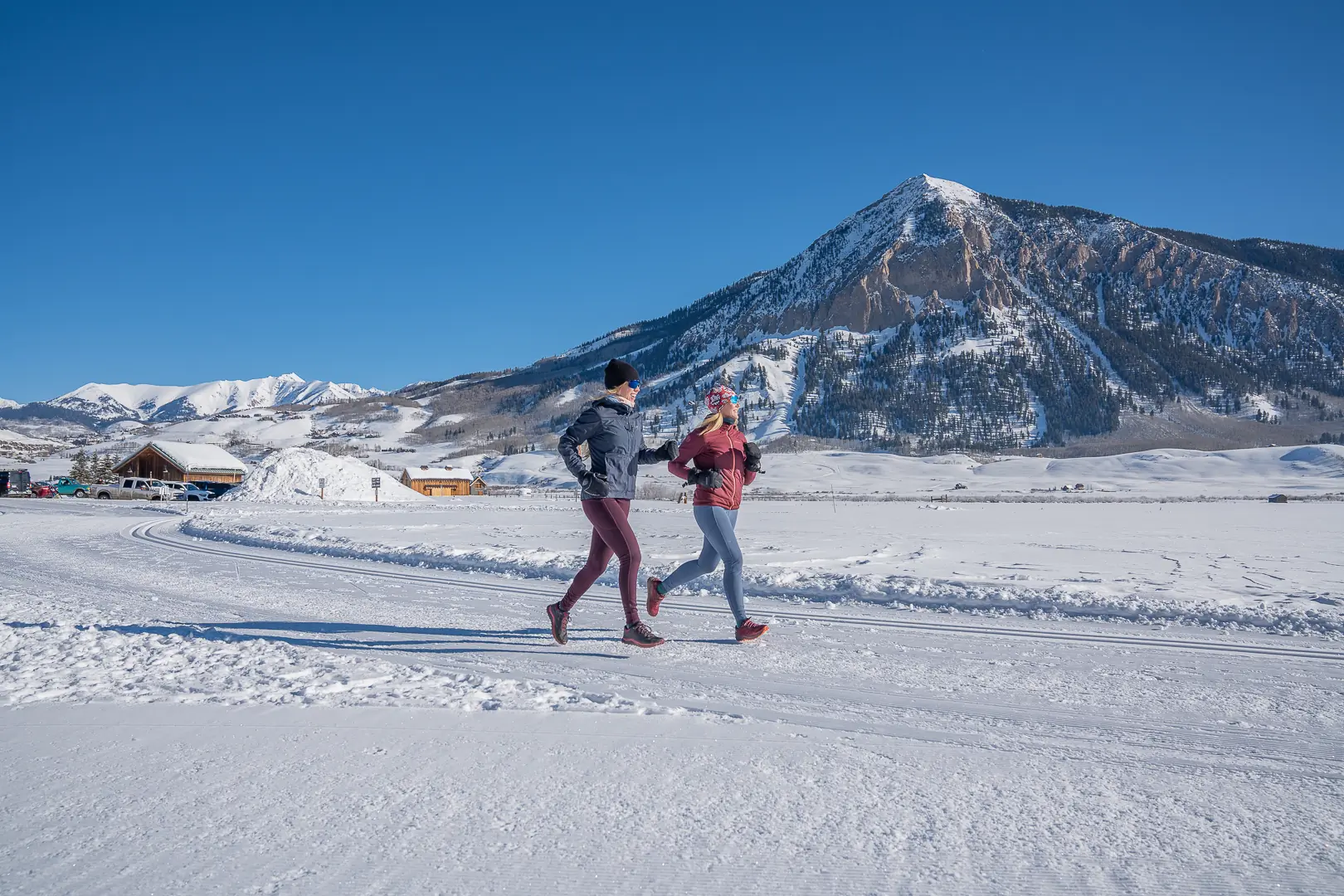



Other brands create an in-house label to help consumers recognize their environmentally conscious manufacturing efforts like New Balance’s Green Leaf Standard. A product meets the guideline if 50% or more materials are sourced as “environmentally preferred,” meaning the fabric could contain recycled fibers or the sourcing is sustainable. For instance, the New Balance Impact Run Heat Tight contains 88% recycled polyester, meeting the Green Leaf Standard.
For some apparel, the face fabric is coated with a water-resistant treatment to repel precipitation called DWR (durable water repellent). Traditionally, the chemicals in DWR have been full of toxins that are unhealthy for humans and the planet and that don’t biodegrade.
Called fluorocarbons (aka perfluorocarbons or PFCs), those chemicals are extremely resilient and extend a product’s durability and life. When a product includes a PFC-free DWR, like the Rabbit Defroster Speed Tights, that’s a worthwhile note, and we haven’t noticed a price hike or a drop in performance due to the eco-upgrade.




Insulation & Warmth: Women’s Winter Running Tights
Picking out the ideal level of insulation in your women’s winter running tights will depend on what conditions you are climatized to, your personal health and needs, and the typical winter environment where you will run.
Are you traveling to a colder climate than you are used to? You might want to pack a fleece or wool-lined tight. If the temps are rarely below 30 degrees Fahrenheit and there’s no biting wind chill, you’ll most likely be fine with a tight that has no brushed fleece or wool. However, if there’s humidity or a breeze or gust that brings the temperature down, that extra layer of protection will be beneficial.
If you live in a place that consistently receives teeth-chattering wind, look for a tight that’s specifically reinforced to block chilly gales, like the Smartwool Women’s Active Fleece Wind Tight or Craft ADV Essence Wind Tights, which have windproof front panels. Also, find a pair with a length that reaches all the way down to cover the ankle.
Types of Insulation
The primary types of insulation in winter running tights include:
- Brushed fleece like the liner in the Rabbit Defroster Speed Tights
- Merino wool, which is both the interior and main body of the Smartwool Women’s Active Fleece Wind Tight
A brushed fleece or merino wool lining feels super cozy next to skin while the fabric blends are smoother.
A thicker knit or density can help buffer against the cold like the polyamide/elastane blend in the above-knee inserts that are integrated into the On Running Performance Tights.




Thermal Insulation of Clothes (CLO) Rating
One label that helps runners identify warm apparel is a Thermal Insulation of Clothes (CLO) rating. CLO is used to measure warmth levels across different materials. For example, boxer briefs have a CLO of 0.04, sweatpants have a CLO of 0.28, and a winter coat would reach around 0.70 CLO. Nakedness is zero.
CLO has the potential to be a helpful marker for buyers but not every brand shares a CLO rating or per product, making it difficult to compare values.
Furthermore, some variables can’t be accounted for within the unit of measure: Beyond fabric, sustaining adequate body warmth also depends on the user, their specific biometrics, workout intensity, and the weather.




Breathability
The importance of breathable fabric in winter running tights cannot be overstated. It plays a crucial role in managing moisture and keeping the skin dry and comfortable. Breathable fabrics also help regulate body temperature, preventing overheating during runs. Summer is not the only time when you can overheat.
Overheating during a winter run may seem counterintuitive, but it poses significant dangers. Overdressing for winter runs can cause your body to overheat and sweat more. Just like summer, it can cause dehydration, electrolyte imbalances, increased heart rate, and unnecessary stress on your body. Having breathable fabric is fundamental.
The best winter running tights will be made with breathable fabrics, such as merino wool or a synthetic blend. The materials used directly correlate with their moisture-wicking and drying capabilities, which are crucial steps for breathability.
Moisture-Wicking & Quick-Drying
In addition to adequate insulation, you’ll need a fabric that wicks sweat and quickly dries, to help prevent you from getting clammy, cold, or experiencing a drop in body temperature, potentially leading to hypothermia. The other factor to manage is layering appropriately so that you don’t get chilled but don’t oversweat, either.
One benefit of wool, which is in the Smartwool Women’s Active Fleece Wind Tight, is that the natural fiber has a large capacity to wick perspiration away from your body so you are left less moist after a workout.
Other brands have their own proprietary synthetic fabrics that are designed to quickly wick moisture and dry fast: The NB Heat cold-weather fabric in the New Balance Impact Run Heat Tight, FlashDry in The North Face Women’s Winter Warm Pro Tights, the DriLayer Threshold fabric in the Brooks Momentum Thermal Pant, and the AdvancedSkin ActiveDry fabric in the Salomon Cross Warm 28”.
We’ve found that both wool or synthetic blends work well to absorb moisture on a run. However, synthetic materials tend to dry a bit faster than wool. Though, wool retains warmth better when damp.
You’ll ultimately want to stay away from any fabrics with cotton, which absorbs sweat but stays wet.




Windproofness
Again, depending on your climate, windproofness might not be necessary. Or, for light wind, a fleece-lined or thicker tight might be enough of a shield. But for those who live in climates where winter also brings a much colder wind, windproof panels make a big difference.
Wind is an element that will let you know how fast (or not) your layers are wicking sweat, drying, and can quickly create a potentially dangerous situation. The more active you are, the more sweat you create. Windproof panels help cut the cold, ultimately keeping you warmer, while your tights are wicking away moisture.
This was a main factor for why the Craft ADV Essence Wind Tight was our top pick for the best women’s windy climate winter running tights: The design has wind-resistant front and back panels providing 360 wind protection to our most susceptible areas.
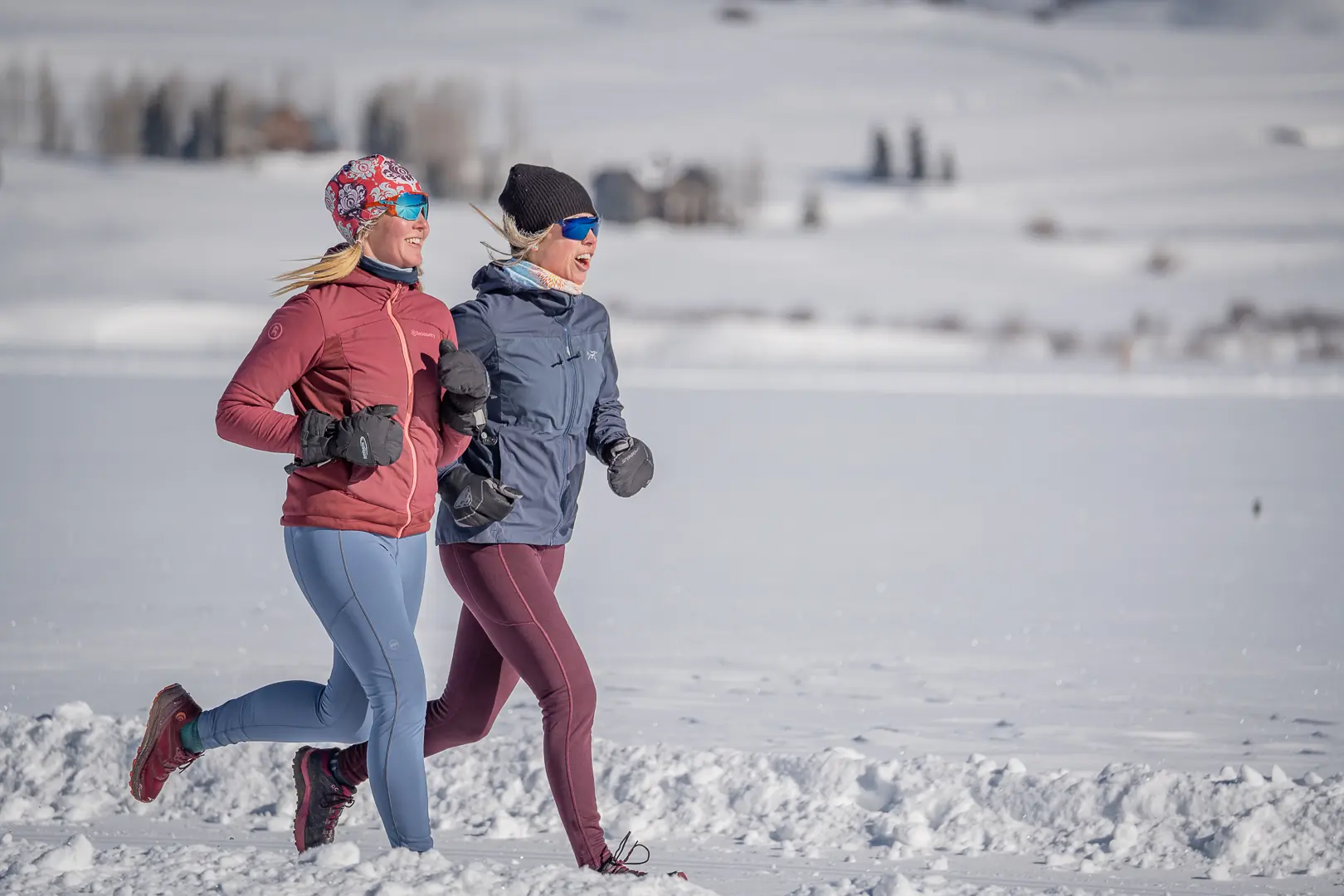



Smartwool Women’s Active Fleece Wind Tight is not far behind with a DWR finish and windproof front panels that are rated super strongly at 0 CFM (cubic feet per minute), a metric for windproofness based on the ability of 30-mph wind to pass through 1-square-foot of material. A lower digit means that the fabric more effectively blocks wind:
- 1 CFM or less is considered windproof
- 10 CFM signifies extreme wind-resistance
- 20 CFM is baseline wind resistance like a windbreaker jacket
- 60 CFM means the wind moves through like a woven shirt or fleece jacket
The potential tradeoff? Windproof panels are not as breathable. If you invest in a pair of winter tights with protective panels and it’s not windy, the tights will be overbuilt and might not be as breathable, and comfortable, as you’d like, especially if you’re running fast or uphill and need to dump heat.
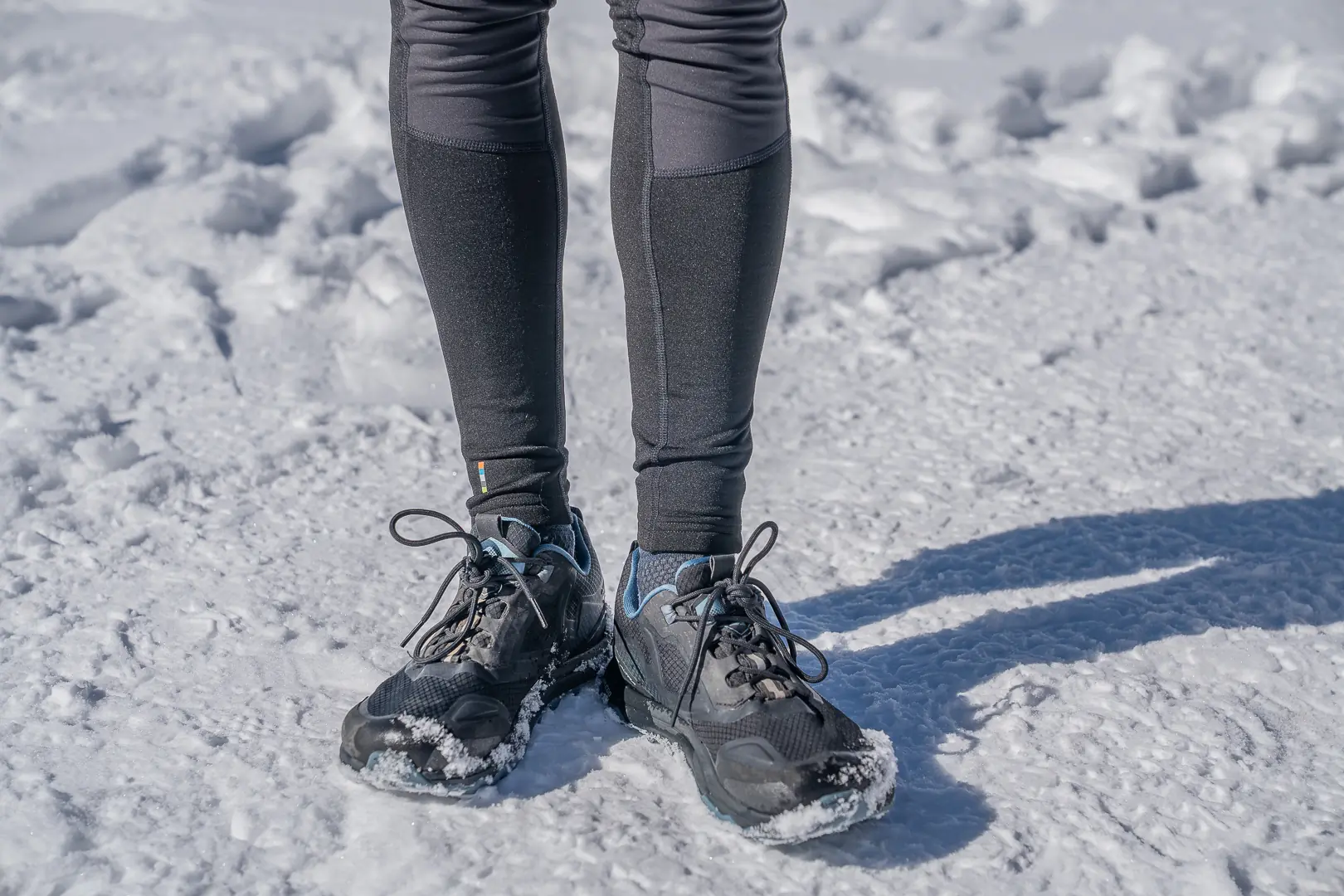



Waterproofness & Water Resistance
For the days when you won’t be running in a storm, waterproofness or water resistance is a second thought. However, depending on your climate, the dependability of the weather forecast, and your running goals, you might find yourself pacing through a wet winter storm — planned or not. That’s when the urgency of blocking precipitation becomes apparent.
Water-resistant and windproof tights differ but are similar in the fact that they both can help protect you from getting too cold, a dangerous aspect of winter running.
Waterproof means water cannot penetrate the fabric. Think fishing waders: No water is getting in unless you fall into the river — allowing water to enter through the top — or poke a hole in the material. Waterproofness is achieved through the material and how the piece of apparel is constructed such as taped seams.
Generally, waterproof material is not very breathable and a completely waterproof tight would not be comfortable to run in. However, perhaps a pair of winter running tights with strategically placed waterproof panels could be a happy medium.
Water-resistant fabric has a water-protective treatment applied to the garment, so that water beads up on the face of the material. Called DWR (durable water repellent), the coating is traditionally toxic so look for PFC-free DWR, which is void of perfluorocarbons or PFCs, also known as fluorocarbons.
Having a water-resistant tight will make your runs far more comfortable while zipping beneath snowflakes, sleet, or drizzling rain. When an untreated or non-enforced tight gets wet, the material won’t wick as well, which can leave sweat on your skin and cool you off.
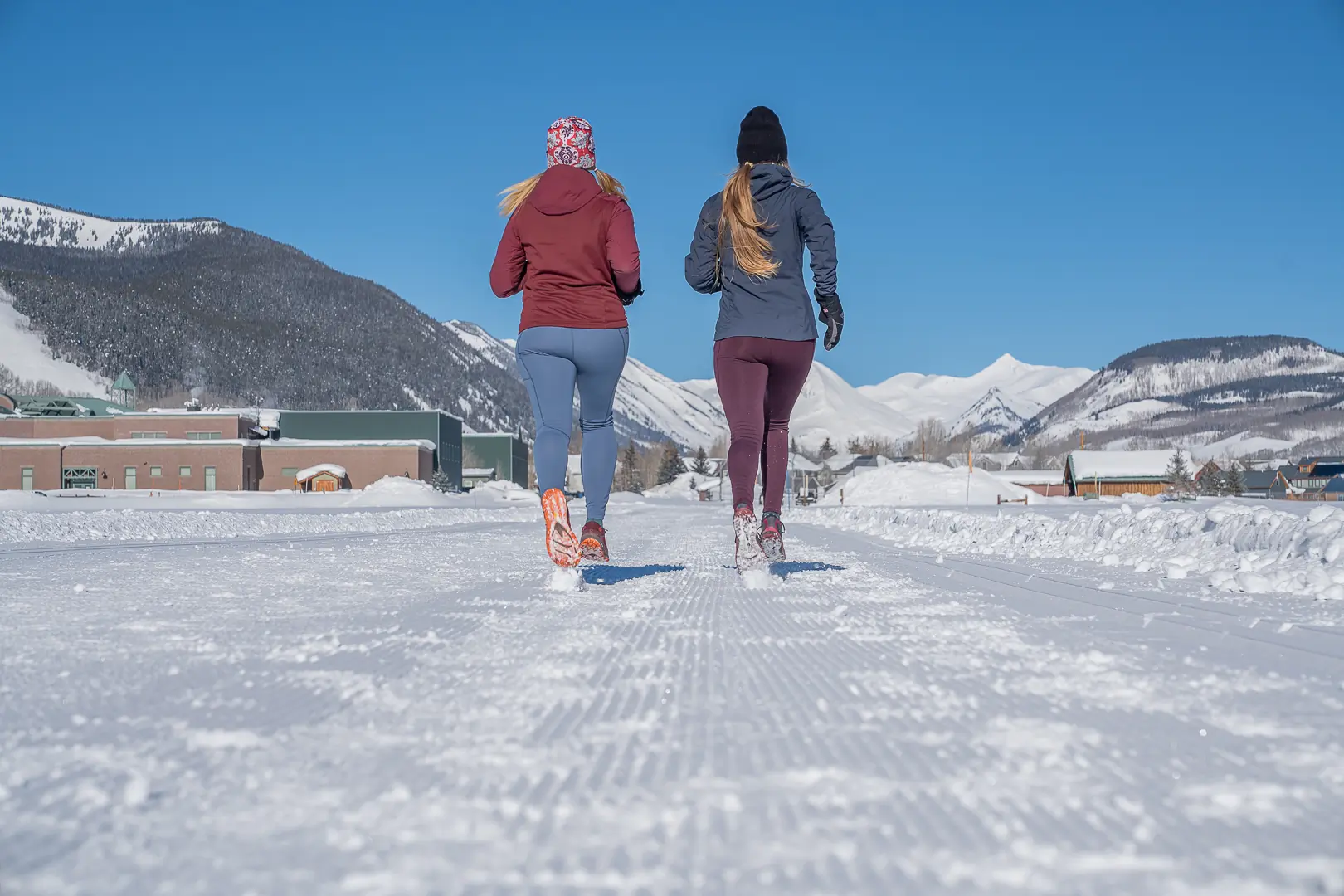



Durable Water Repellent (DWR)
As stated above, Durable Water Repellent (DWR) is a chemical made with perfluorocarbons (PFCs- learn more here) that is applied to a garment to make them water-resistant. The effect of the DWR on a fabric degrades over time, and depending on use, needs to be reapplied through an at-home wash like Grangers.
For decades, companies used long-chain (C8) fluorocarbon-based treatment as it performed the best. However, the PFCs were found to have harmful effects on human health and the environment. Once its negative long-term environmental impact and toxic by-products were discovered, it was rendered unsuitable despite its outstanding performance. Some environmentally conscious brands swapped to a C6 treatment which is based on a shorter-chain of fluorocarbons that breaks down faster in the environment.
Many brands are trying new and innovative techniques to move away from the traditional PFCs used including PFC-free DWR. Brands like Helly Hansen have come up with proprietary blends of Lifa fiber paired with polypropylene membrane, which prevents water from getting in yet still allows the vapor to release. They’ve been using this technology for over 50 years.
The best women’s winter running tights that have water-resistant capabilities include the Rabbit Defroster Speed Tights, which has a PFC-free DWR, as does the Smartwool Women’s Active Fleece Wind Tight.




Seams
Seam placement and construction can make a run go smooth or terribly wrong.
Chafing is the main concern when it comes to seams. When you try on a tight, make sure to move in various positions (stretch a bit and walk around) noting how the seams feel.
If you notice a seam rubbing the wrong way, double-check and make sure the tag, fabric, and any underlayers are not twisted or wonky. If a cause isn’t determined, know that the discomfort will only get worse. Chafing is not to be messed with.
Basically, chafing can occur anywhere a seam is located including along the side of the leg, groin, or around the ankles.
Well-made athletic apparel, including the La Sportiva Primal Pant, often use a flatlock seam: Two pieces of fabric are placed side-by-side and then stitched together rather than having the two pieces of fabric overlap, which leads to a bulge.
Typically, you’ll notice two seams on athletic tights, on the exterior and interior. But the Salomon Cross Warm 28” tights avoid an interior seam altogether, which helps negate chafing along the inner thigh.
Some designs have laser-cut hems, which minimize chafing with overlapped socks or on super-long runs.
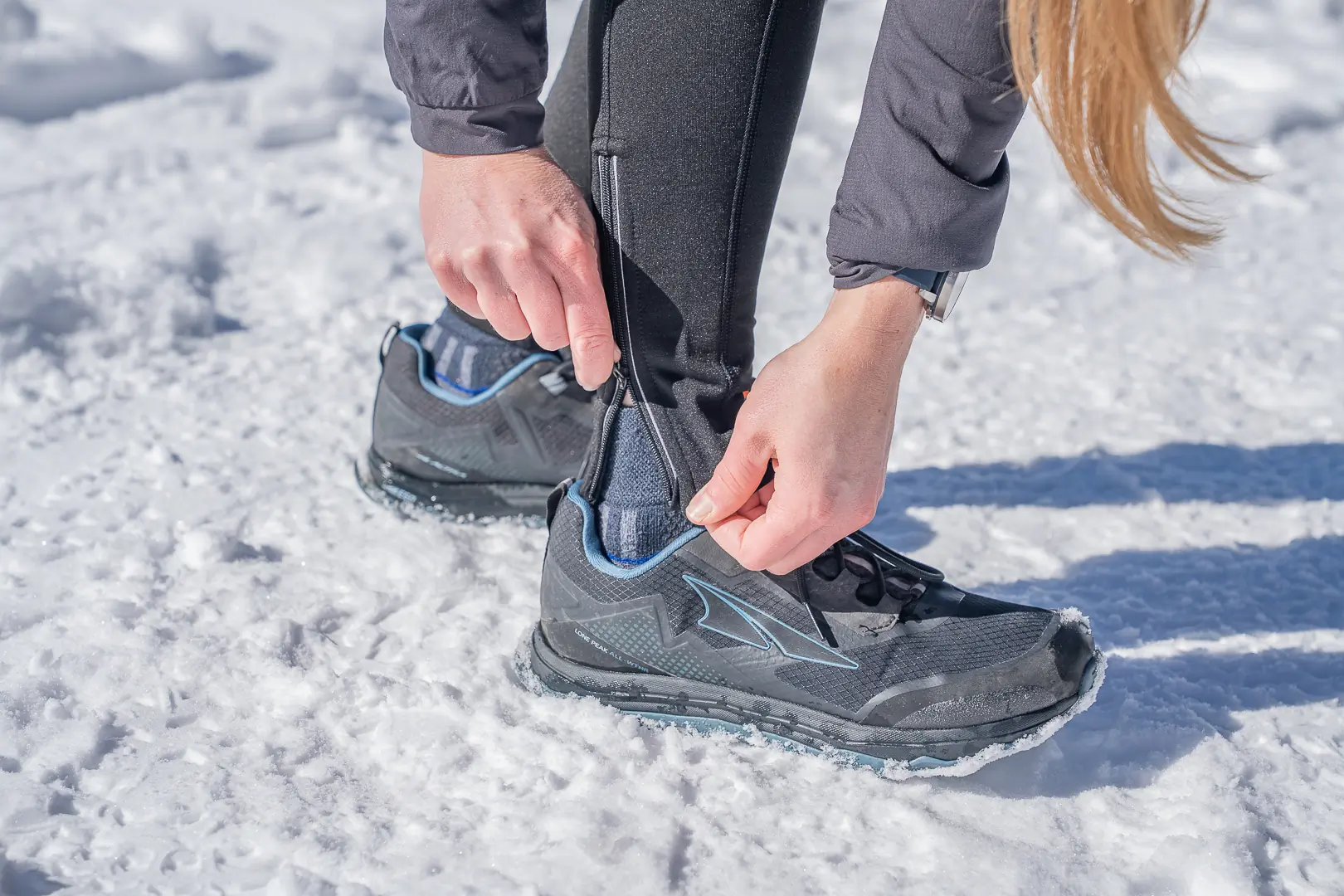



Ankle Zippers
When you consider chafing, take a close look at tights with zippered ankles. The benefit of zippered ankles is that you can more easily pull on and off a well-fitted tight, and you can more easily layer the tight with long socks.
When you pull ‘er up, you can secure the ankle zip to help keep the winter elements off your skin. Below the zipper, you’ll often see an underlay, a soft piece of fabric that lines the inside, preventing the metal teeth from touching skin.
An underlay discourages chafing and blocks the wind from getting through the zipper choppers. Be sure to try on the tights, fully test out the ankle zips, and make sure there are no odd friction points in that zone. Our favorite zippered winter running tights are the Craft Subz Warm Running Tights 3, Smartwool Women’s Active Fleece Wind Tight, and La Sportiva Primal Pant.




(Groin) Gusset
A gusset is a triangle- or diamond-shaped piece of material sewn into high-friction areas, in order to redistribute the stress placed on the seams. Here, gusset refers to the fabric patch in the groin area of winter running tights. We call out whether or not a pair of tights has a gusset in the bulleted specs of each product in the guide.
Durability goes up with a gusset, which replaces what would otherwise be a meeting point for all four seams, creating a potential weak spot. A single seam can also lead to a friction point and cause chafing in your netherlands, especially on long-distance runs. Ouch!
Whether you are team undies or not, a gusset is usually more comfortable, prevents chafing, and can help eliminate any potential visible display of the pubis bone.
If you want to make a quick comparison of which of these tights have gussets or not, scroll back up to the comparison chart.
To test the gusset (or non-gusset) in a pair of tights, do some high knees, leg swings, and squats to see if you feel restricted in any of those motions. Look in the mirror to make sure you are happy with how the seam placement appears.
Friendly reminder: Always use proper testing etiquette by wearing undergarments when trying on clothing until they are yours to keep.
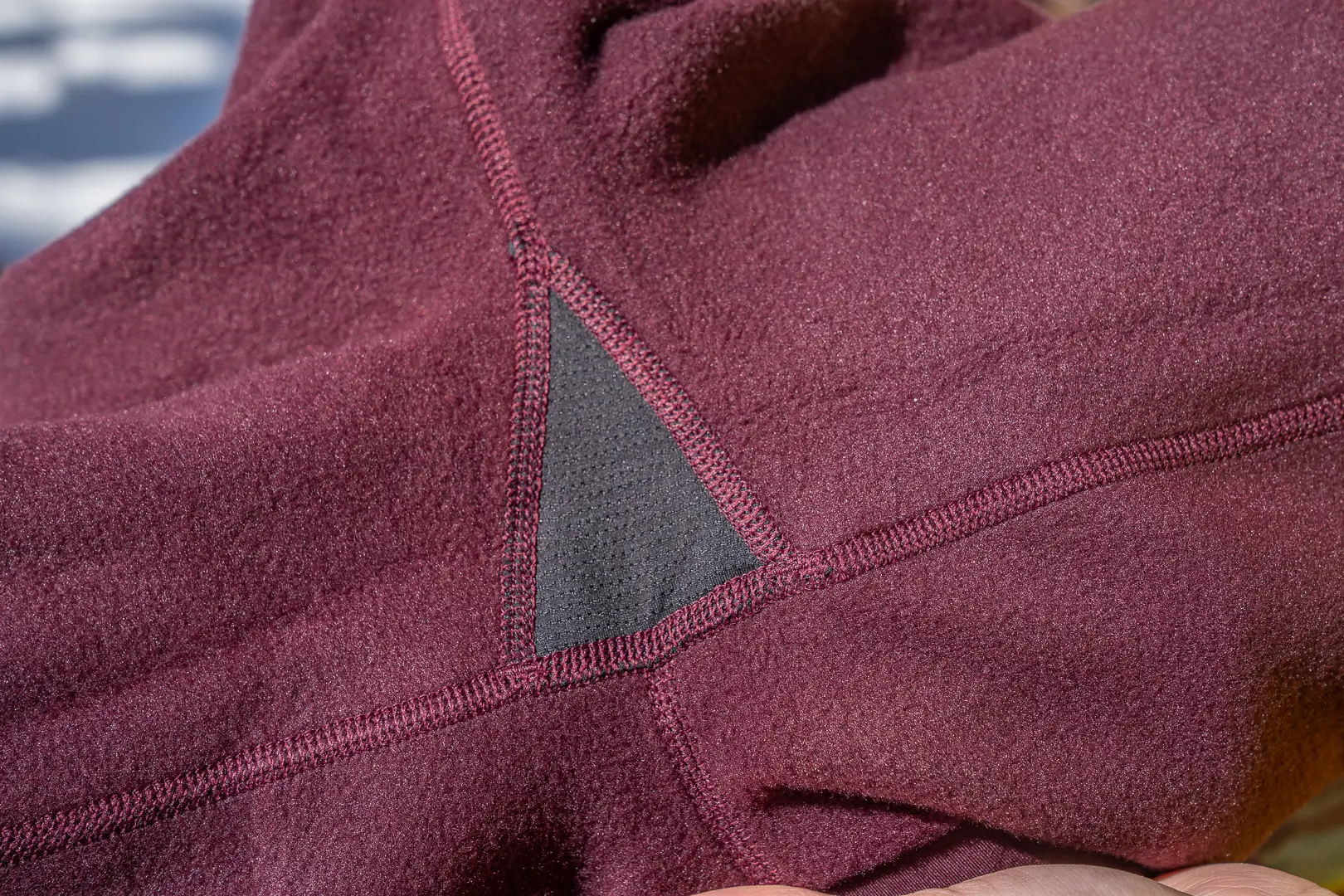



Waistband
Waistbands are another component that can easily make or break a run. Is the high waist too high and suffocating you? Did the drawstring come untied … again?
When trying on tights, move around to check the feel and fit of the waistband. Bend down and tie your shoe: Does the band tighten, pinch, flip or roll down, or is there a gap in the back? Does the waistband have an internal drawstring that pulls out easily and enough to tie? When you tighten down the drawstring, does the waistband feel secure enough?
Some runners with shorter torsos may struggle with a high-rise pant. For others, a mid-rise or low-rise might fit just right. Our bodies are wonderfully different, making it impossible for brands to get the fit perfect for everyone. The likeability of a waistband will ultimately be a personal preference.
Check each company’s return policy as you hunt for the right fit.
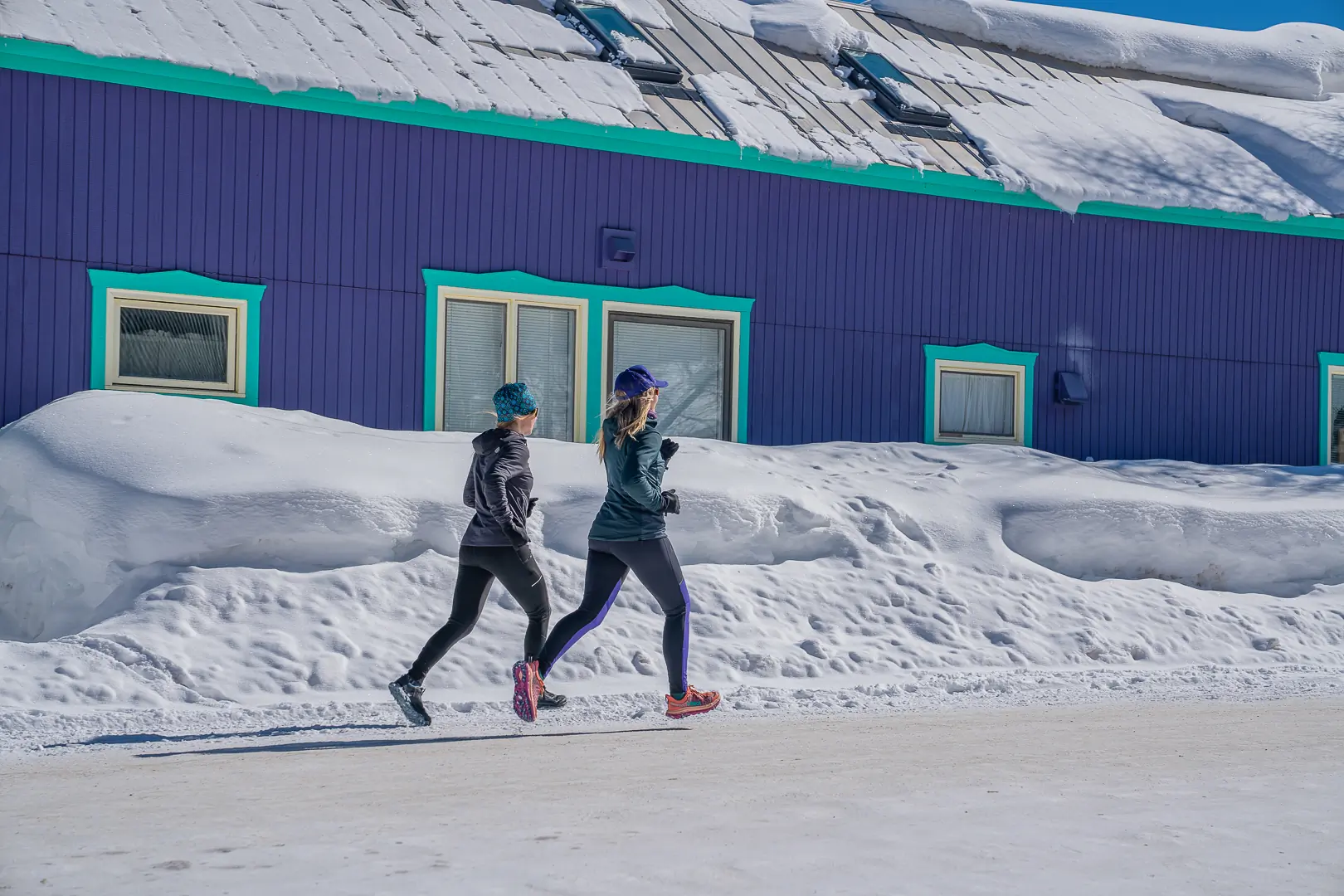



Reflectivity
Reflective details on winter running tights enhance visibility and safety during low-light conditions. In winter’s shorter, darker days, visibility is often compromised, especially during early morning or evening runs. Strategically placed reflective elements on running tights significantly increase the wearer’s visibility to passersby. These reflective details bounce back light from sources such as headlights or street lamps, making the runner more noticeable from a distance.
Our top pick for winter running tights with reflective details is the Craft ADV Essence Wind Tights. These tights not only provide the necessary safety with their 6 different reflective details but also offer a cozy and warm running experience.
However, we advise against relying solely on your leggings for reflective safety when running in the dark. There are many other tools available, such as light-up vests, reflective jackets, and headlamps, that can further enhance your visibility.
If you’re interested in more tips on running in the dark, check out this article by the GearJunkie team. They’ve compiled their top tips for running in the dark, which could be beneficial for your safety and running experience.
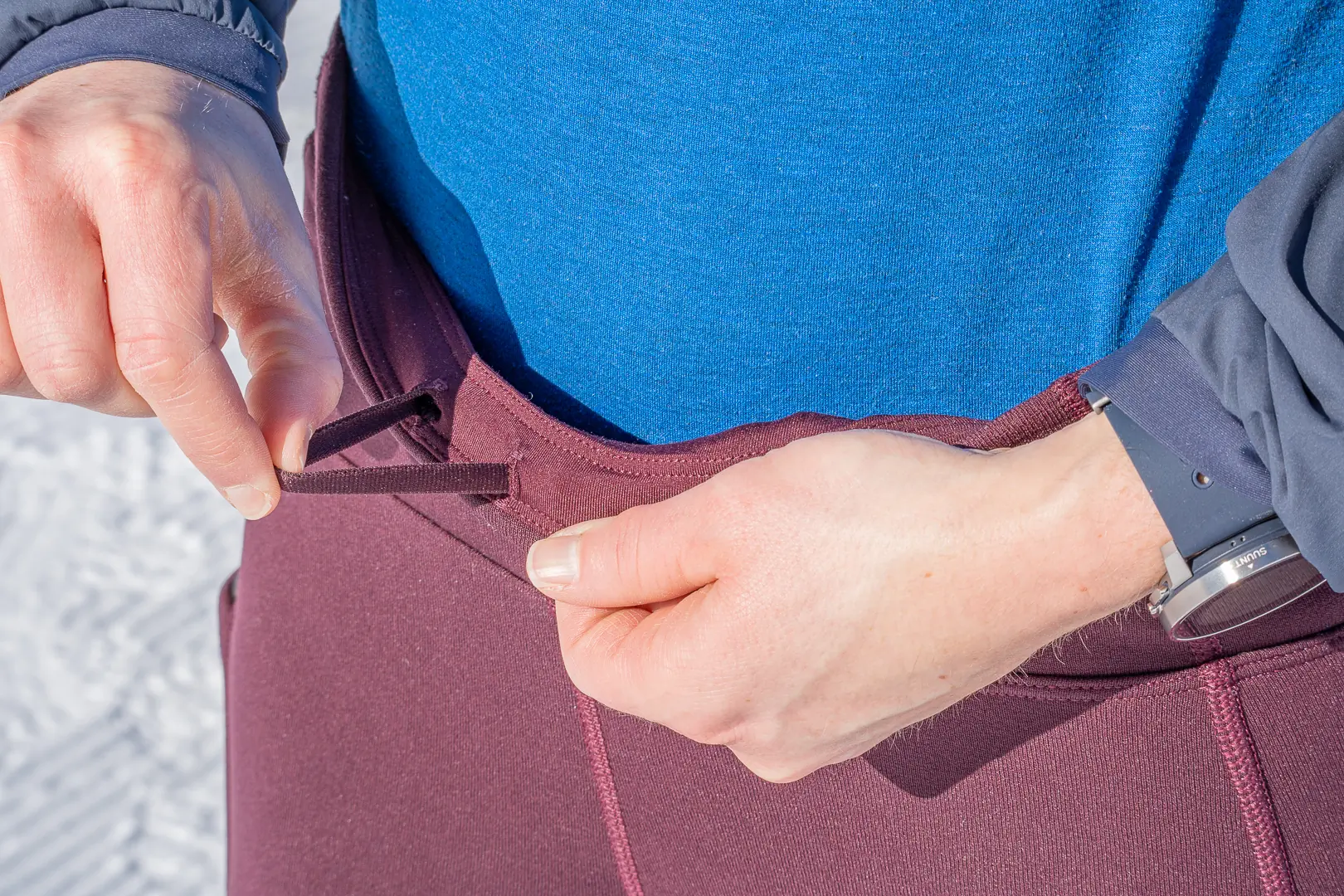



Pockets
Determining if pockets are needed on your runs will help you find the best women’s winter running tight for the colder season.
The pocket designs on women’s winter running tights come in a variety of sizes, shapes, and placements.
Usable pockets are an asset. But poorly designed pockets can be a recipe for frustration with lost items such as fuel, keys, and cards.
To that end, we go into thorough detail for each product review about how the pockets performed on our selected winter running tights.
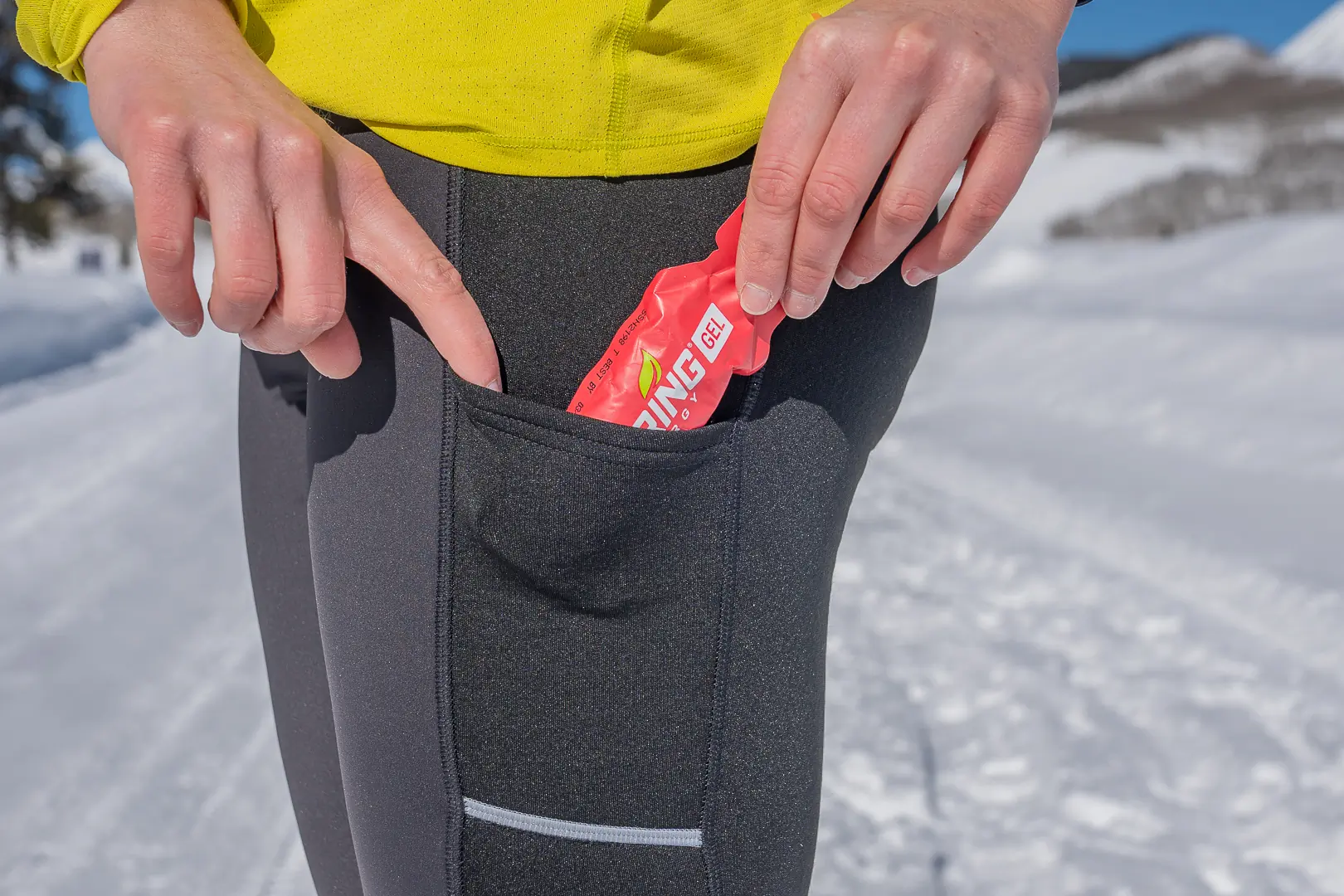



Types of Pockets
Winter running tights usually have a combination of these types of pockets and rarely have no pockets at all:
- Side compression pockets on thigh or hip
- Zippered pockets on thigh or lower back
- Internal waistband pockets
- External waistband pockets




Pocket Closures
Zippered pockets are often smaller and located on the thigh or waistband. They keep your items safe without the fear of things bouncing out.
Pay close attention to non-enclosed, slip-in pockets or envelope pockets, which have a flap of fabric that fold over the top seam. You don’t want your things to pop out when they jostle around.
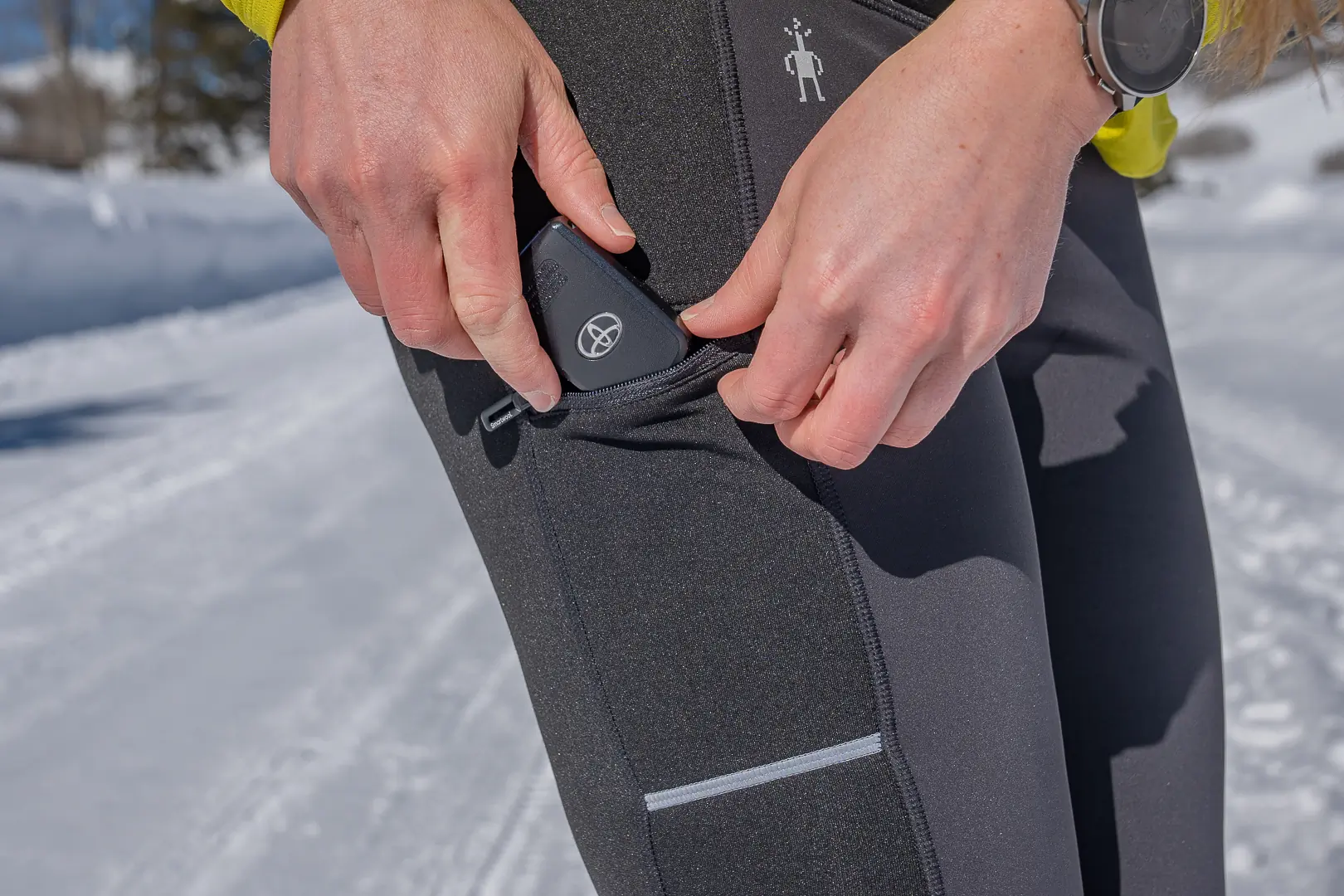



Pocket Materials
Pockets can be crafted from the same material as the tight, a mesh, or a different fabric altogether.
We’ve found that thicker fabric can also help prevent condensation build-up on a device during physical activity. For instance, The North Face Women’s Winter Warm Pro Tights has two large lined thigh pockets that can secure a large phone, and we never saw a sweaty phone screen or camera lens.
Mesh pockets are not ideal for winter tights as they offer no warmth for your devices or snacks and will not protect items from the elements.
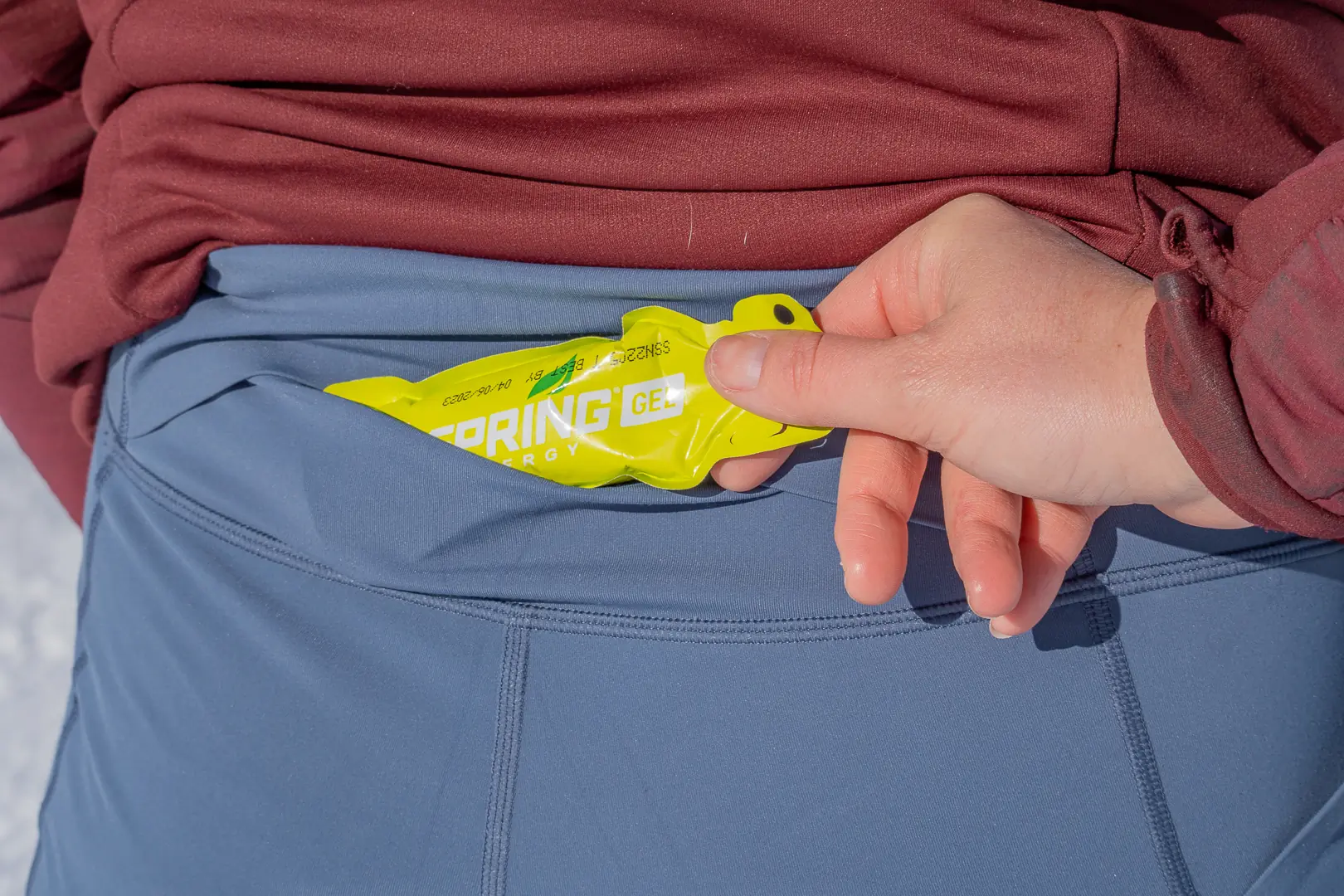



Pocket Sizes
Hip or thigh pockets are usually large enough for phones and purposely don’t have a zipper for easy slide-in access. Larger pockets are also a nice place for glove liners.
Smaller pockets located around the hips, lower abs, or lower back are typically a good spot for small- or medium-sized snacks, credit cards, IDs, keys, a headband, SPF 15 chapstick, or travel-size sunscreen.
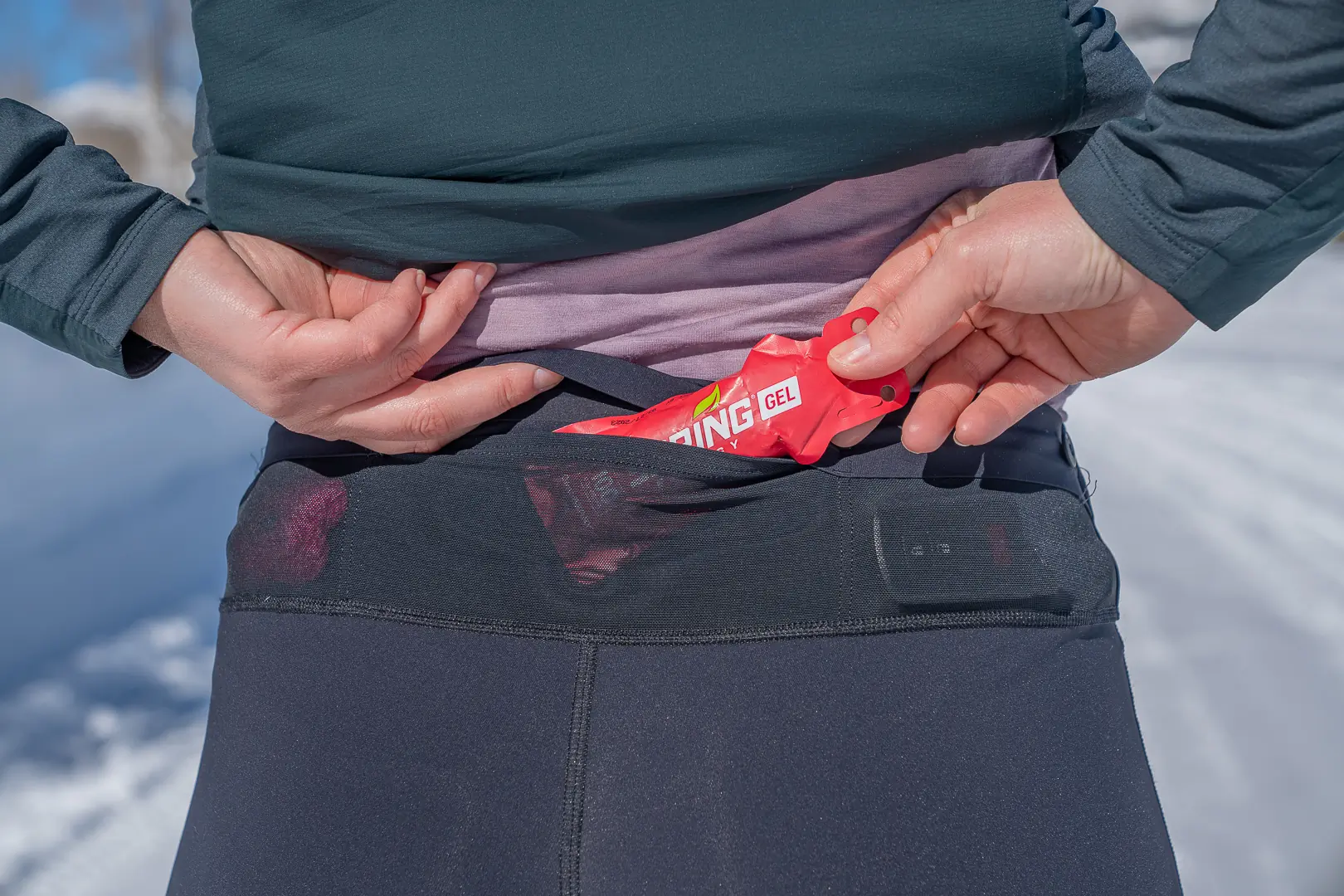



Number of Pockets
The number of pockets varies across designs. Our top choices for women’s winter running tights range anywhere from one to five pockets, though the majority offer five pouches.
- 5 pockets: The North Face Women’s Winter Warm Pro Tights, REI Co-op Swiftland Thermal Running Tights – Women’s, Rabbit Defroster Speed Tights
- 4 pockets: New Balance Impact Run Heat Tight
- 3 pockets: On Running Performance Tights, La Sportiva Primal Pant, Patagonia Women’s Peak Mission Tights 27″
- 2 pockets: Brooks Momentum Thermal Pant, Smartwool Women’s Active Fleece Wind Tight, Salomon Cross Warm 28”
- 1 pocket: Craft Subz Warm Running Tights 3, Craft ADV Essence Wind Tights
How many pockets you need will depend on what you want to bring and if you are wearing other apparel or accessories that offer storage like a jacket, handheld bottle with a stash pocket, or a running pack, vest, or belt.




How to Choose the Best Pockets
Think about what items you want to stash in your pockets. Then make sure the pockets are correctly sized and secure enough to keep those articles from flying out. Do you prefer a zippered pocket for security? Does your phone fit into the drop-in pocket on the thigh or hip?
If you usually run with additional storage, the Craft ADV Essence Wind Tights offer only one pocket and the design might be a good fit: a zippered pouch on the back of the waistband. Comparatively, the Rabbit Defroster Speed Tights has ample capacity with five pockets including a zippered waistband chamber.
Additionally, consider the pocket placement. Are the receptacles placed in comfortable spots for your body? Are the pockets accessible while wearing a running jacket, vest, or hip pack?
Check out the comparison chart above to learn which tights have pockets and how many. Refer to each product review to see if those specific pocket designs suit your needs.
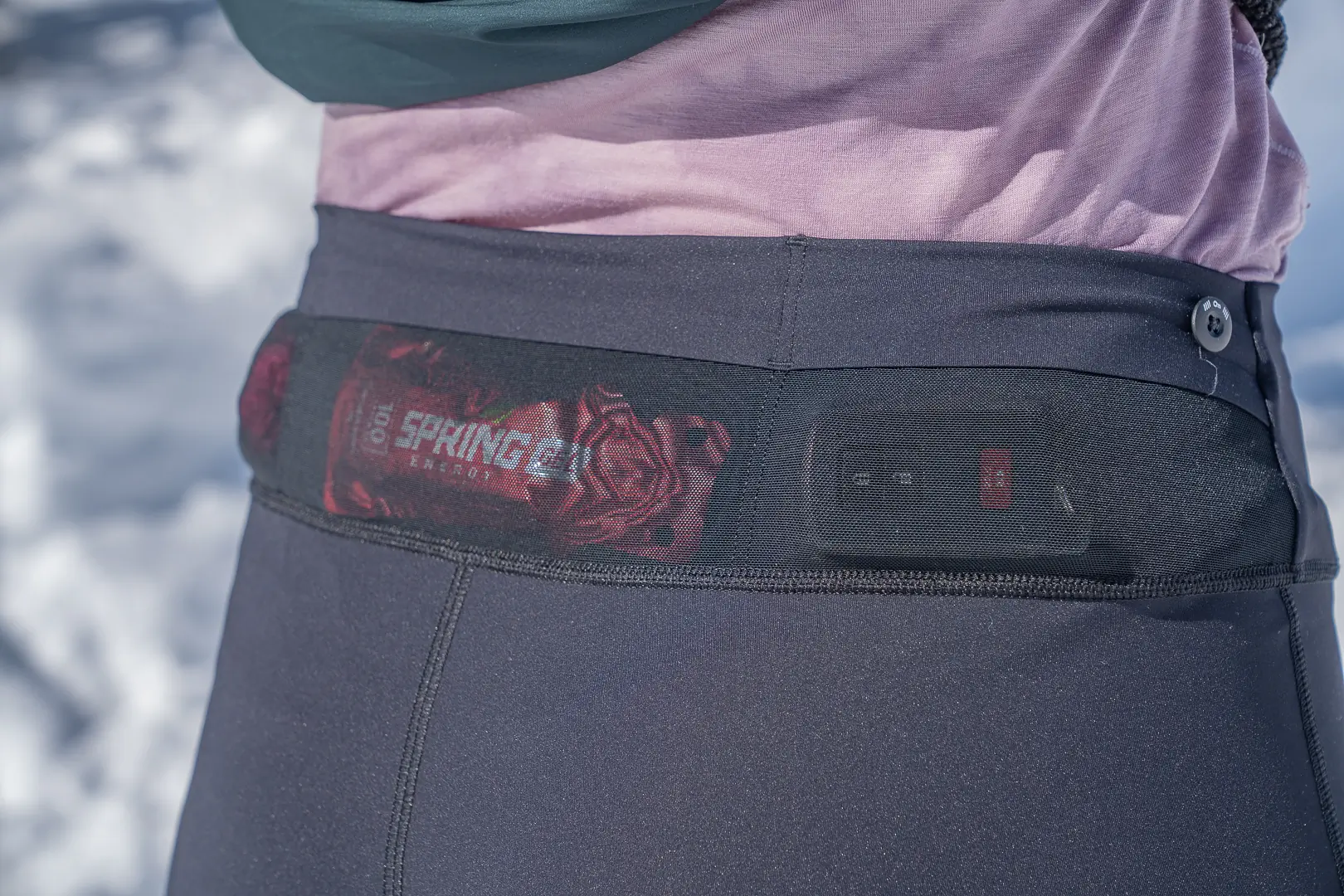



Sizing: Women’s Winter Running Tights
Getting the right size of winter running tights is crucial to having the best experience. It’s a bit like Goldilocks — you want them to be snug but not too tight, just right.
Each brand will have its own size chart. It will include measuring your hips, waist, and inseam. To measure around your waist, loop the measuring tape around the smallest part of your waist. For your hips make sure your feet are together and loop the tape around the fullest part of your hips.
Lastly, for the inseam, measure from the top of your inner thigh down to your ankle. Take your measurements and look at the sizing chart, whichever you are closest to is the size you want to purchase. If you are in between sizes or have questions, customer service is usually there to help.
Be sure to note the rise of the rise of the waist. Winter running tights come in mid-rise, high-rise, and super high-rise. Finding the right rise of a tight is usually based on a personal preference and how the rise fits on you will depend on your torso length. Make sure to read the legging’s description on the rise and see what feels more comfortable on you.
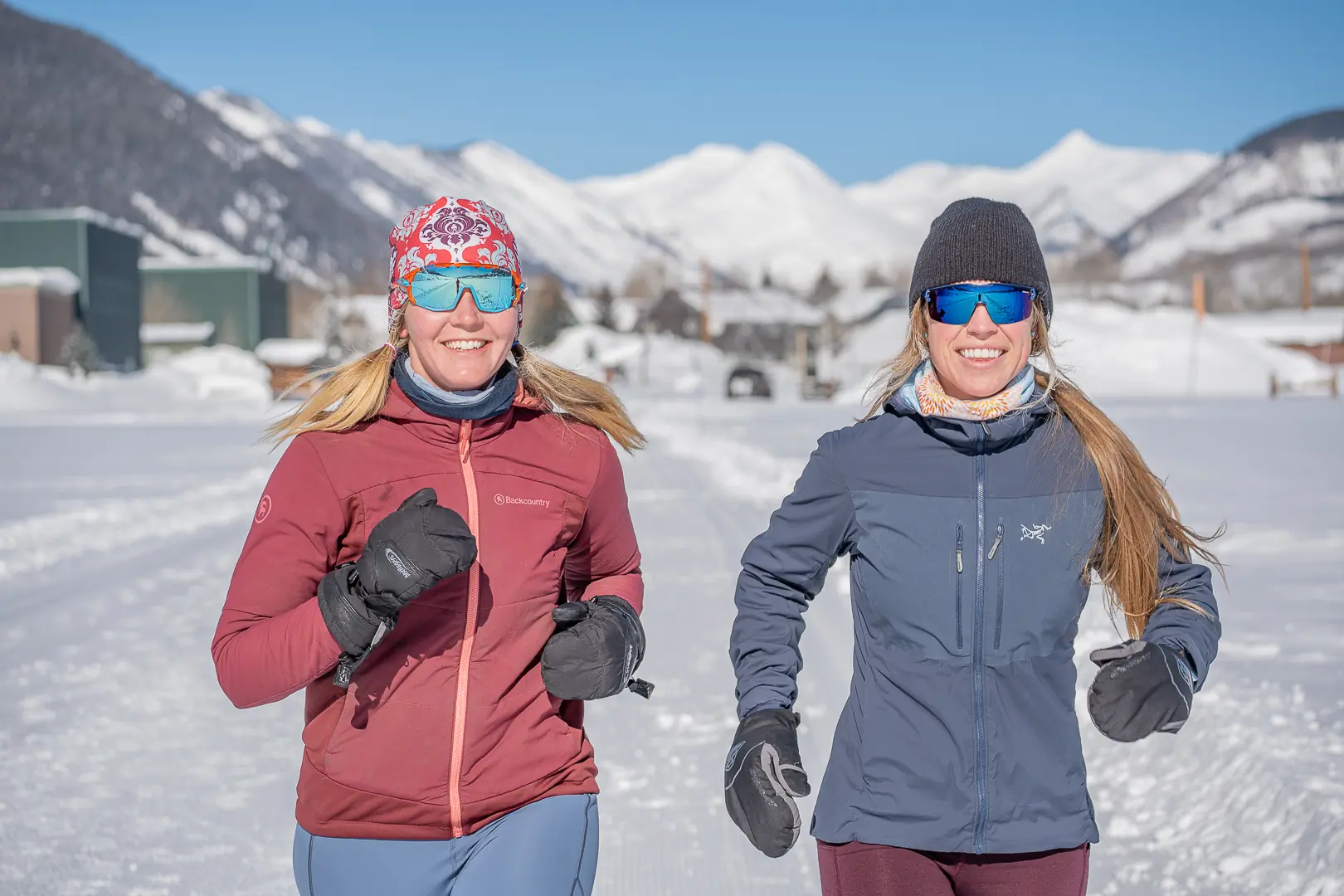



How to Layer
Layering, a crucial aspect of winter running, is the key to ensuring you stay warm, dry, and comfortable throughout your workout. It’s a strategy that involves dressing like the temperature is 20º warmer than the thermometer says. This may seem counterintuitive, but as your run progresses, your body temperature will rise, keeping you warm.
However, there are exceptions to the 20º rule. For instance, dressing 20º warmer for a 10º run is still below freezing. Moreover, factors like humidity and wind chills can make the temperature outside colder than the thermometer says. In such conditions, you may need to dress warmer. The key is to adapt your layers to keep your core temperature comfortable.
- Start with a moisture-wicking base layer for your top to keep sweat away from your skin. Look for materials like merino wool or synthetic fabrics such as polyester or nylon. Avoid cotton, as it retains moisture and can make you feel colder.
- Add an insulating midlayer for warmth over your base layer. A technical fleece jacket can work well for this purpose. This layer should provide insulation while still allowing moisture to escape.
- Choose a windproof and/or waterproof jacket as your outer layer to protect against the elements. Look for one with breathable fabric to prevent overheating and allow moisture to escape. If it is downright cold, consider adding an insulated jacket to your layers. An outer layer with reflective elements can also help increase visibility during darker winter days.
- Don’t forget to protect your extremities. This includes wearing a hat to prevent heat from escaping through your head, gloves to keep your hands warm, and a neck gaiter or scarf to shield your neck and face from cold winds. Opt for moisture-wicking socks to keep your feet dry and warm. Consider wearing thicker socks or layering thin ones for added insulation.
- For shoes, opt for winter-specific shoes or trail running shoes with good traction to prevent slipping on icy or snowy surfaces. You can also choose waterproof shoes to keep snow and moisture from seeping into them.
Pay attention to the weather forecast and adjust your layers accordingly. If it’s freezing, windy, or wet, you may need to add an extra layer. Conversely, if it’s milder, you can remove layers to prevent overheating.
By layering appropriately, you can stay comfortable and safe while running in winter. Listen to your body and adjust as needed during your run.
One last layering tip: when you finish your run, get out of your sweaty clothes as soon as possible. We like to have a fresh shirt and even a down jacket waiting in our car for a quick change. Getting too chilled after a run can be dangerous and adds unneeded stress to your body.




Eye & Skin Protection
In winter, sunscreen and sunglasses remain essential for safeguarding your skin and eyes despite the cooler temperatures.
Even though the sun is lower on the horizon during winter, the sun’s UV rays can still reach your skin, posing serious health risks such as sunburn, premature aging, and an increased risk of skin cancer. Snow can amplify this exposure by reflecting up to 80% of the sun’s UV rays. By applying sunscreen, you create a protective shield that significantly reduces these risks.
The snow glare can be particularly harsh on your eyes. Sunglasses with UV protection and polarized lenses are crucial for shielding your eyes from this glare and reducing the risk of conditions such as snow blindness: a temporary loss of vision due to intense light reflection off snow.
Winter winds can carry dust, debris, and snowflakes, potentially irritating your eyes during your run. Sunglasses not only shield your eyes from these elements but also act as a wind barrier, preventing dryness.
By incorporating sunscreen and sunglasses into your winter routine, you’re not protecting your skin and eyes from UV radiation, glare, and environmental irritants. You’re also ensuring your overall health and well-being during your year-round outdoor adventures or daily pursuits.
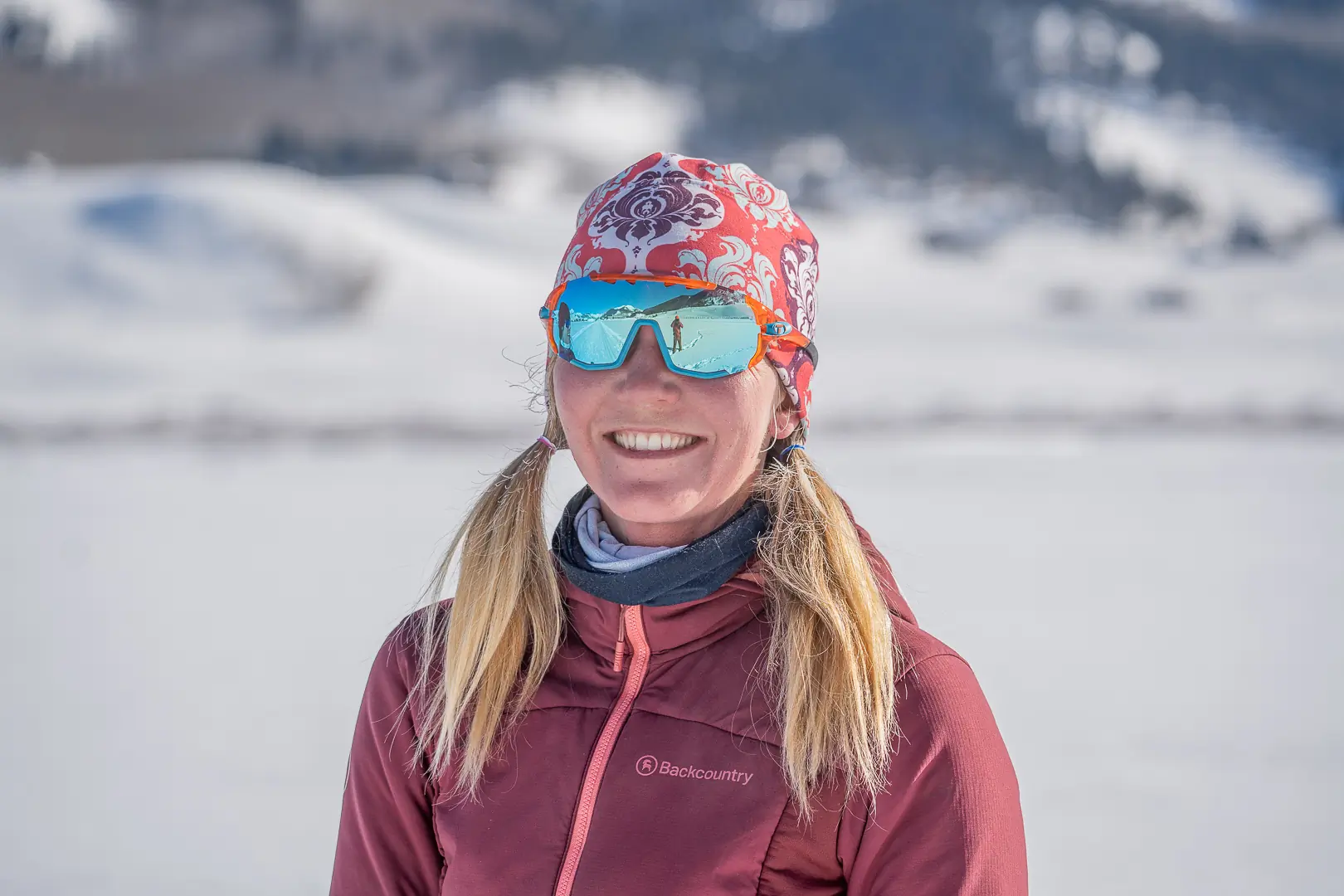



Return Policies & Warranties
The best winter running tights will have a solid return policy. All of the tights we tested have at least a 30-day return window for unused, tags-still-on tights.
New Balance Impact Run Heat Tight has a 45-day return window for like new purchases. Brooks Momentum Thermal Pant has a 90-day “trial run” window where you can return the pants even after using them for free- no shipping or restocking fee. Patagonia Women’s Peak Mission Tights 27″ has no return limit for unused, with tags still on products.
However, you will receive Patagonia store credit a year after purchase instead of a refund. REI Co-op Swiftland Thermal Running Tights – Women’s has the best return policy of all the tights we tested. The bonus here is that it’s not just for the brand of REI; it’s any product purchased from REI (with a few exceptions). For members, you have an entire year to return the tights, even when they are used! For non-members, you have 90 days.
The only two brands that offer a warranty are Salomon and Patagonia. Salomon’s warranty is a limited warranty that lasts for 2 years. They do make it a little tricky by needing the original packaging for the warranty to be valid. Patagonia, on the other hand, has set the bar high for warranties and repair. Instead of having multiple hoops to jump through, they invite it, making it as easy as possible for repairs to happen.
You can go to one of its stores, where they will see if they can fix it in-house, teach you how, or send it in for repairs. If you opt to mail it in, you cover the shipping costs, but the repairs are usually free unless it’s a majorly complicated repair (usually wetsuits or waders).
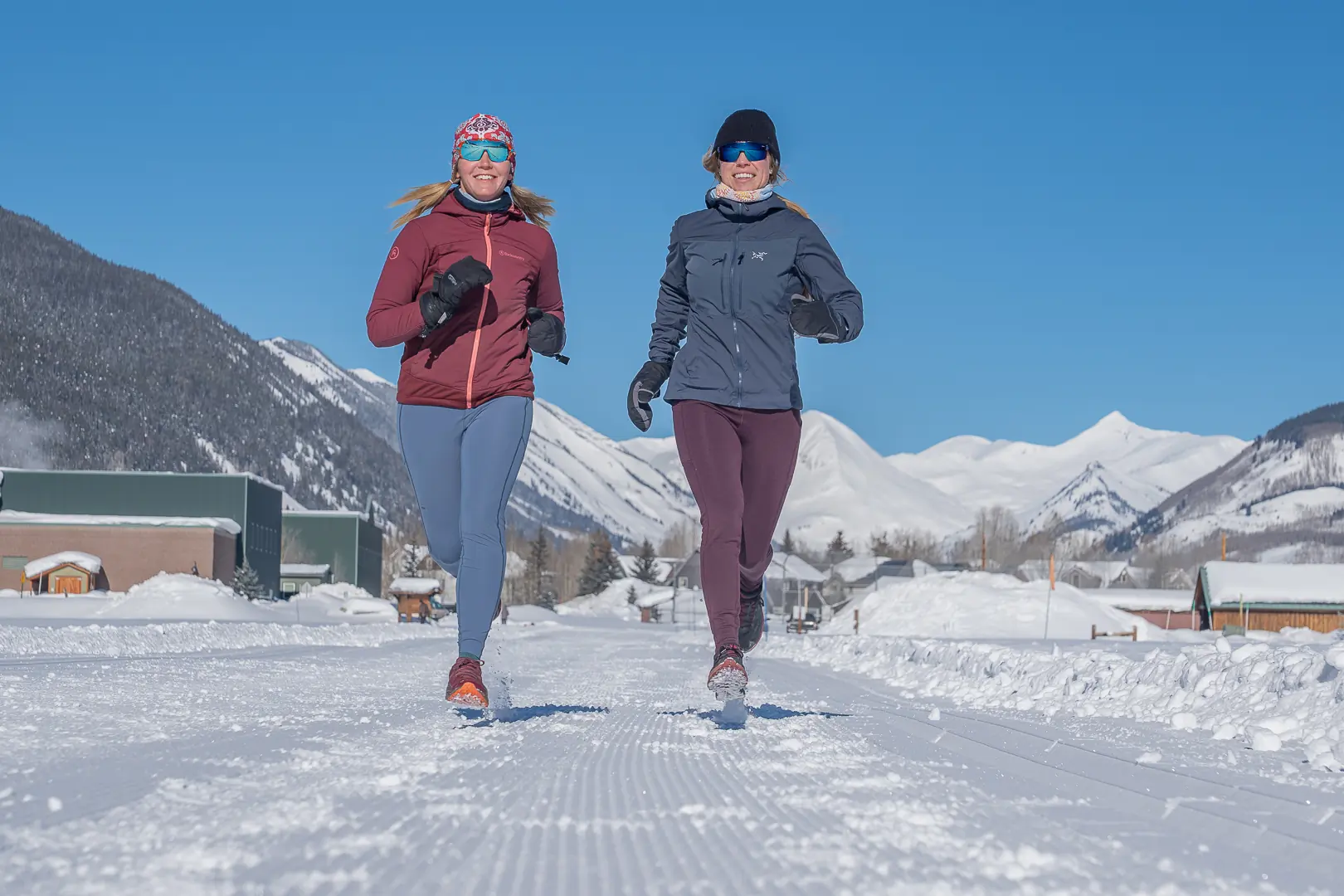



Price & Value
Budget Women’s Winter Running Tights
The lowest prices for women’s winter running tights include the REI Co-op Swiftland Thermal Running Tights Women’s ($85) for cooler year-round conditions and the La Sportiva Primal Pant ($119), which repels moisture.
We haven’t found quality products that drop below those price tags with the exception of seasonal sales. To protect your limbs from the cold, you’ll need at least as much protection as these two pairs, even in mild to moderate climates.
Mid-Tier Women’s Winter Running Tights
Stepping toward the midprice rung, you’ll find The North Face Women’s Winter Warm Pro Tights ($100), Brooks Momentum Thermal Pant ($95), Salomon Cross Warm 28” ($90), and New Balance Impact Run Heat Tight ($90). As the dollars go up, you’ll find greater durability and construction. In these running pants, there are usually additional features like wind-protective panels and unique pockets.
Premium Women’s Winter Running Tights
Reaching above $100, you’ll often find designs with brushed fleece. You’re paying more for a bump up in insulation.
Premium choices include the On Running Performance Tights ($120), Rabbit Defroster Speed Tights ($135), and Smartwool Women’s Active Fleece Wind Tight ($150). Overall, these top-tier designs are more complicated from a technical standpoint and aesthetically — hello, insulation panels on the On Running Performance Tights, which is also made with recycled fabric.
For instance, the Rabbit Defroster Speed Tights are fleece-lined, PFC-free water-resistant, reflective, super warm, and boast five pockets. Wool typically costs more, which you’ll find in Smartwool’s tights.
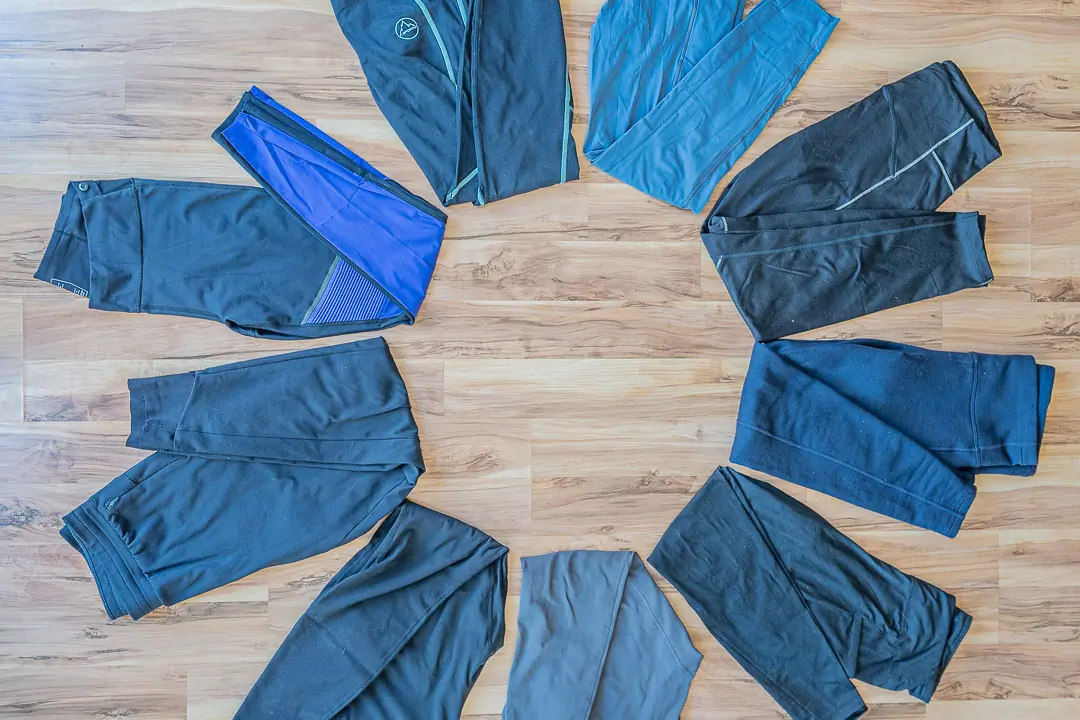



Frequently Asked Questions
The type of winter tight you need is based on the location and weather conditions of where you will be running. Defining your running climate will help you determine which tight is best. You’ll want to consider if the conditions are windy, wet, or cold and to what degree.
If you’re running where it is often windy, check out tights with wind-specific panels.
Tights with waterproofness or water resistance such as a DWR-treated textile are helpful in zones with high precipitation, be it snow or rain.
For running in temps that dip below what your standard tight can keep you warm at, consider designs that are full length with thicker material like a denser knit nylon/polyester or fibers that insulate such as fleece or merino wool.
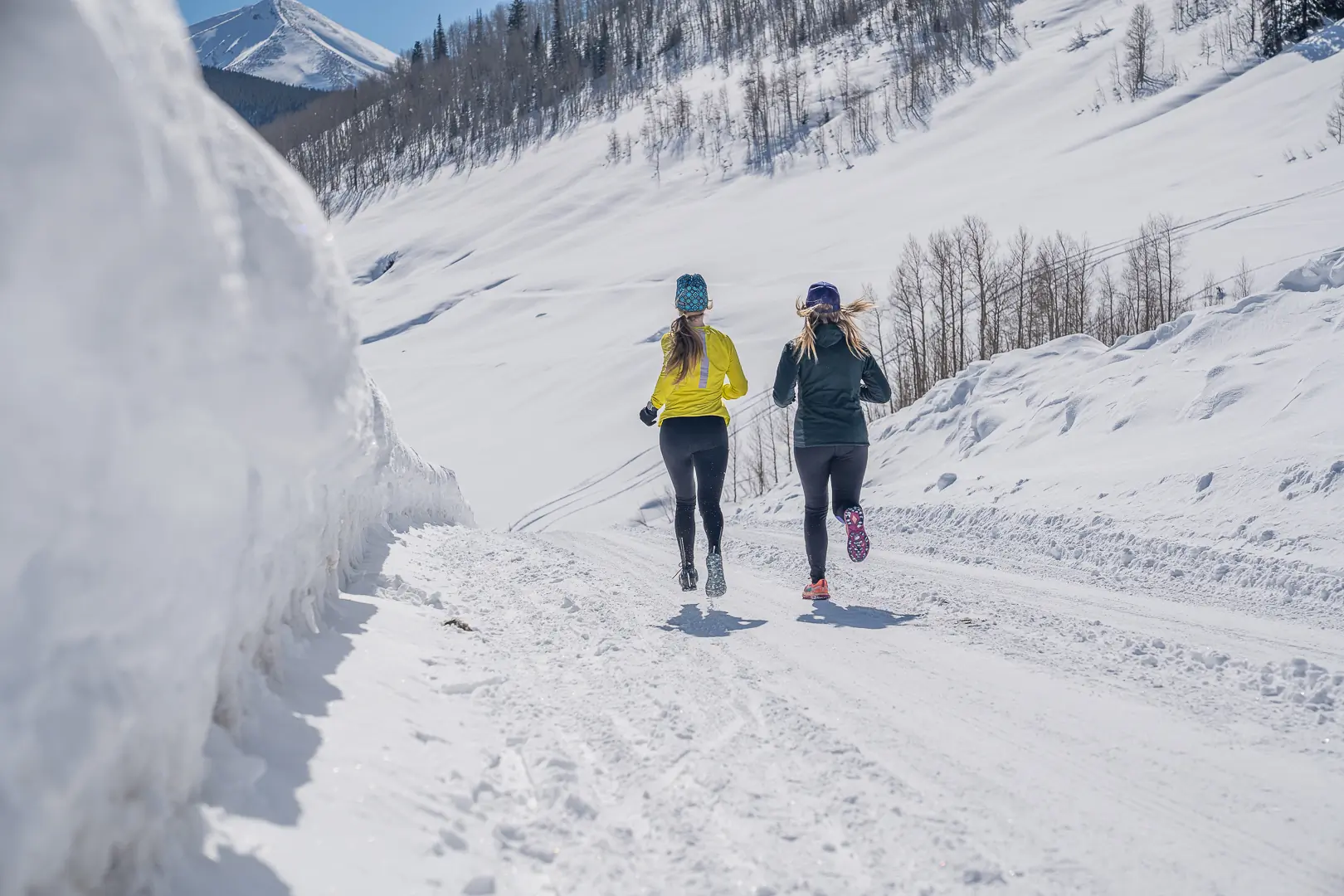



Yes, though some thermal winter running tights focus more on warmth retention than others.
Examine the makeup of the material. Any pant that is fully or partially lined with fleece will be warmer. Wool also increases coziness.
Though, a tight’s ability to wick and release sweat — typically a synthetic blend or wool blend — or block wind can also help you maintain your body warmth, especially after you break a sweat.
Water-resistance and windproofness does not always mean there will be insulation. And just because something is labeled “winter” does not mean it is insulated!
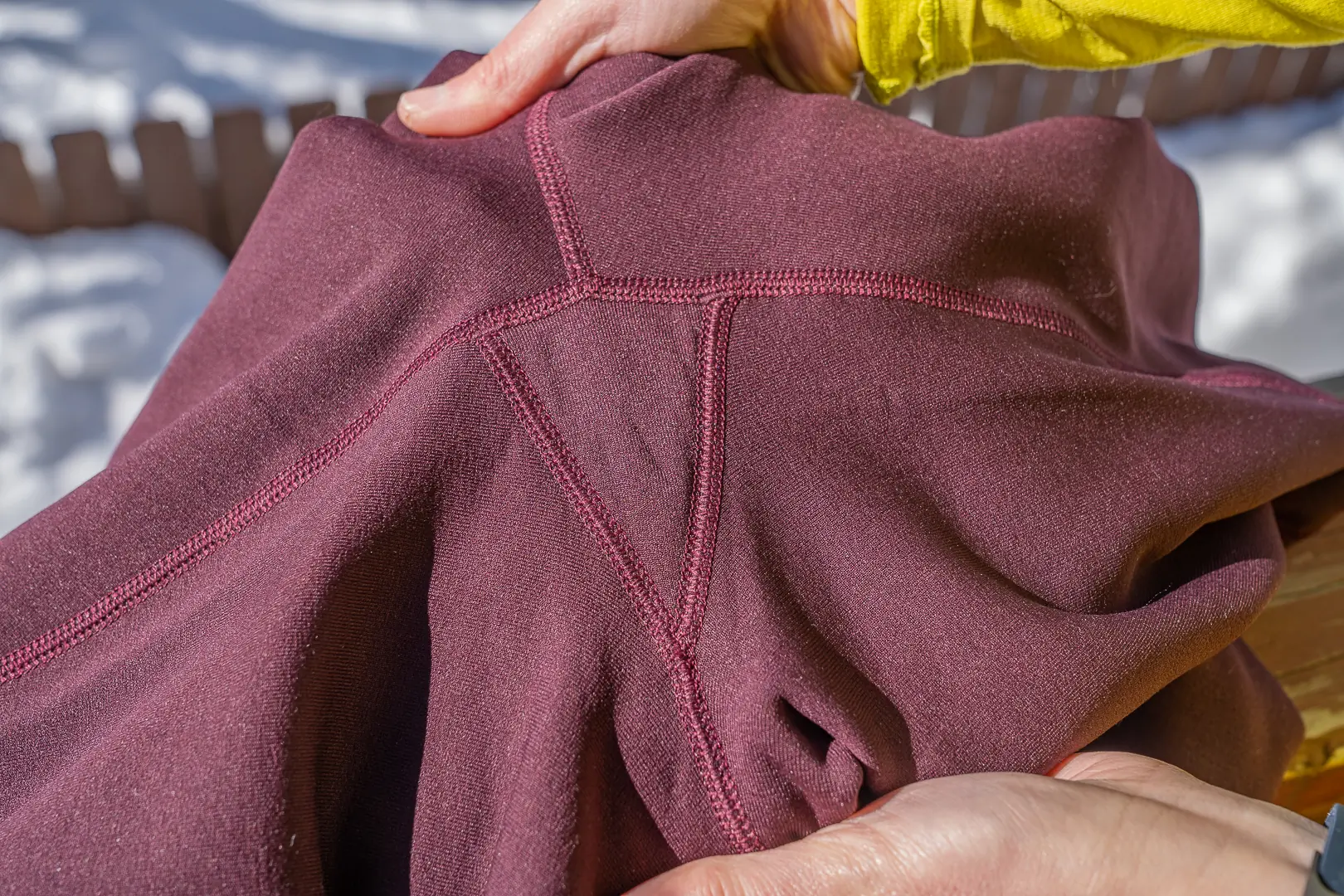



A gusset is a fabric panel that’s sewn into a garment where seams would typically meet at high-friction areas such as the armpits or groin. The panel is often in the shape of a triangle or diamond.
Adding a patch, versus a straight seam, reduces bulk while adding greater breadth and thus range. The wide fabric also enhances breathability in that zone.
The aim? Hopefully an avoidance of chafing, uncomfortable rubbing, or rawness around the upper thighs (a better overall fit can help prevent sag) and between the legs.




After considering the climate where you run, double-check and make sure the tight covers the checklist of what else you need, including storage, if pockets are essential to you.
Reflect on what you plan on taking with you. Make sure there are enough pockets of the style you prefer, i.e., zipped, enveloped, or compression style.
The placement of pockets is just as important. Ensure you can easily access pockets under your jacket or running pack and that you can store heavier items where they are not weighing down the tights, creating sag.
If you plan on running at night, consider prioritizing tights with integrated reflectors, which supplement other brighter running lights that can be worn on your shoes, hip belt, pack, or hat.
You purchased your leggings: Now, it’s time to learn how to best care for them. If you don’t wash them right away after a run, be sure to hang dry them. If you squash them in a ball or leave them in a pile on the floor, sweat and bacteria will grow, breaking down the fibers faster.
When it is time to wash them, make sure you follow the tag’s instructions. Often, it will say to wash in cold water, use mild detergent, and wash with like materials. Never wash leggings with other abrasive materials, like a terry towel. That will cause the fibers to break down faster and pill.
Also, air dry your leggings to help them last longer and avoid any unnecessary shrinkage. Once they are fully dry, you can hang, fold, or roll them to store.
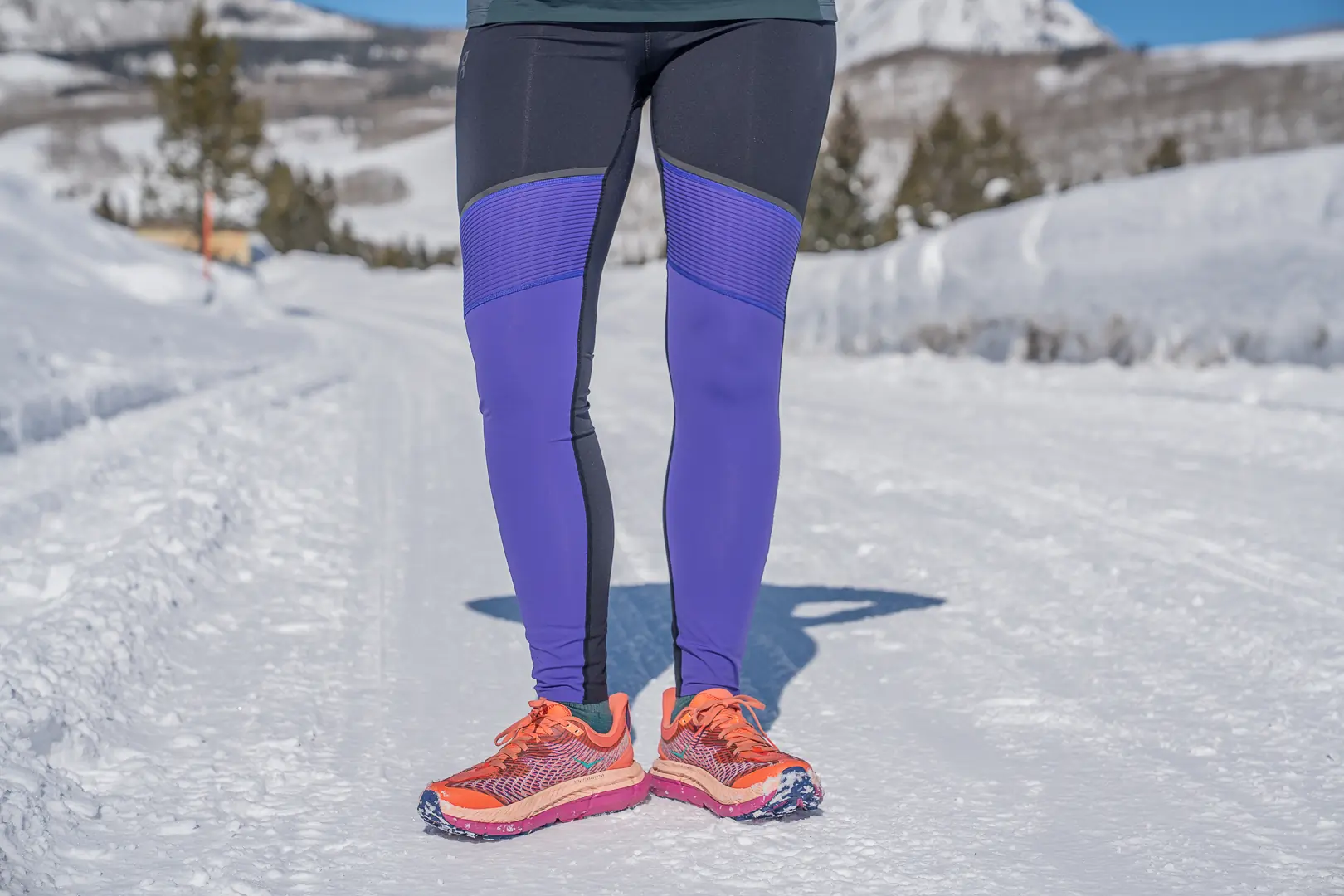



When it comes to leggings, finding the perfect fit is crucial. It’s a bit like Goldilocks — you want them to be snug but not too tight, just right. Pay special attention to the waist area. If it feels constricting and you can’t take deep breaths, it’s a sign they’re too tight. Conversely, if they’re slightly loose, does the drawstring help to cinch them up comfortably?
Another key factor to consider is your range of motion. Do a few leg swings and see how they feel. If you feel significant pulling or restriction, they’re too tight. On the other hand, if they’re saggy and not providing a slight compression, they’re too big.
Remember, every winter running tight comes with a sizing chart. Take the time to measure yourself correctly and find the size that best matches your measurements. And if you’re still unsure, don’t hesitate to reach out to customer service.


The Best Women’s Winter Jackets of 2025-2026
Whether you’re looking for a warm, stylish coat to commute in a snowstorm, spectate a hockey game, or enjoy après-ski, we’ve got you covered with the best women’s winter jackets.
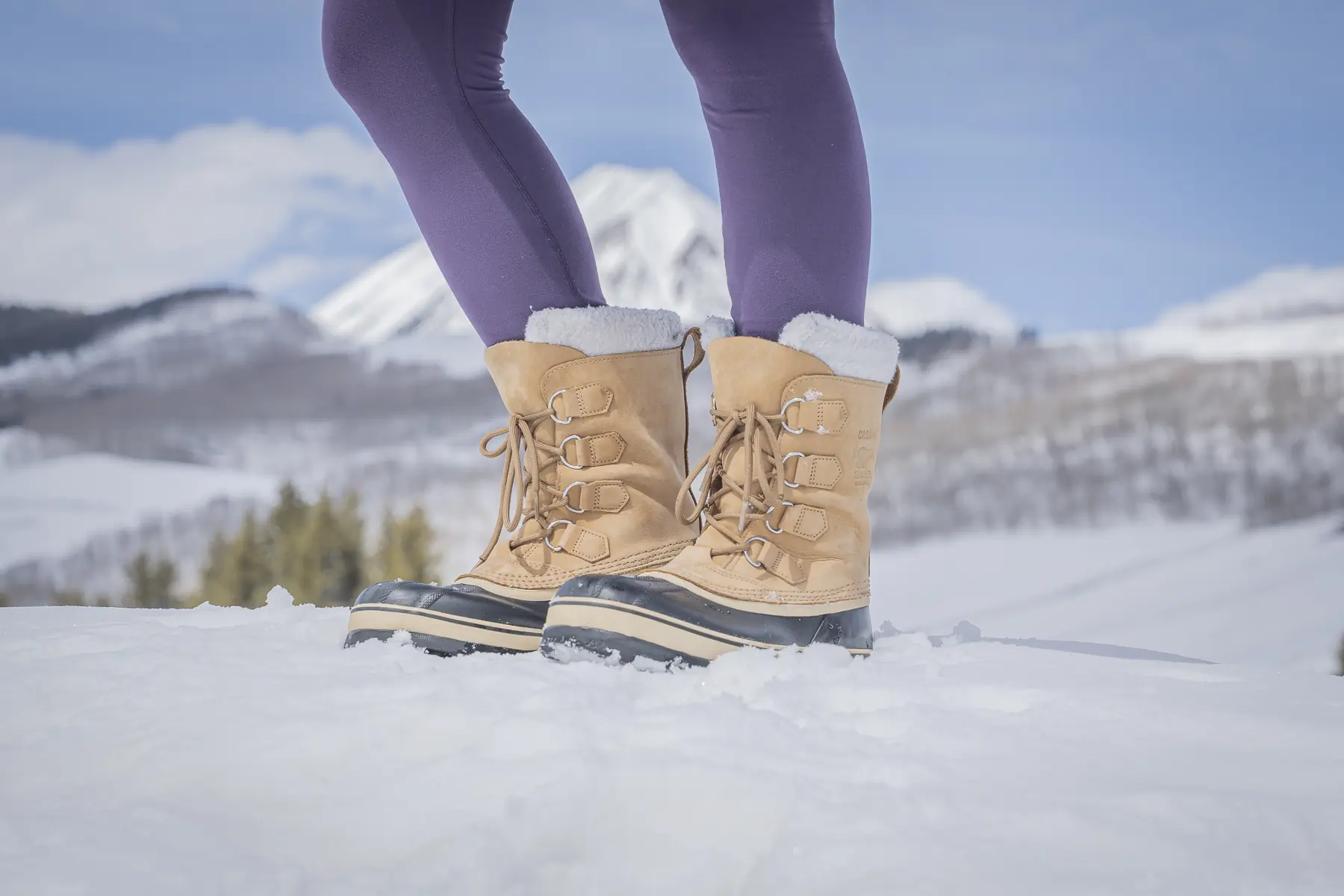

The Best Winter Boots for Women of 2025-2026
We tested the best winter boots for women in cold, snowy, icy, and sloppy conditions. Our top picks include Sorel, Timberland, and more.
